2 Days in Seville: Detailed Itinerary, Map & Tips
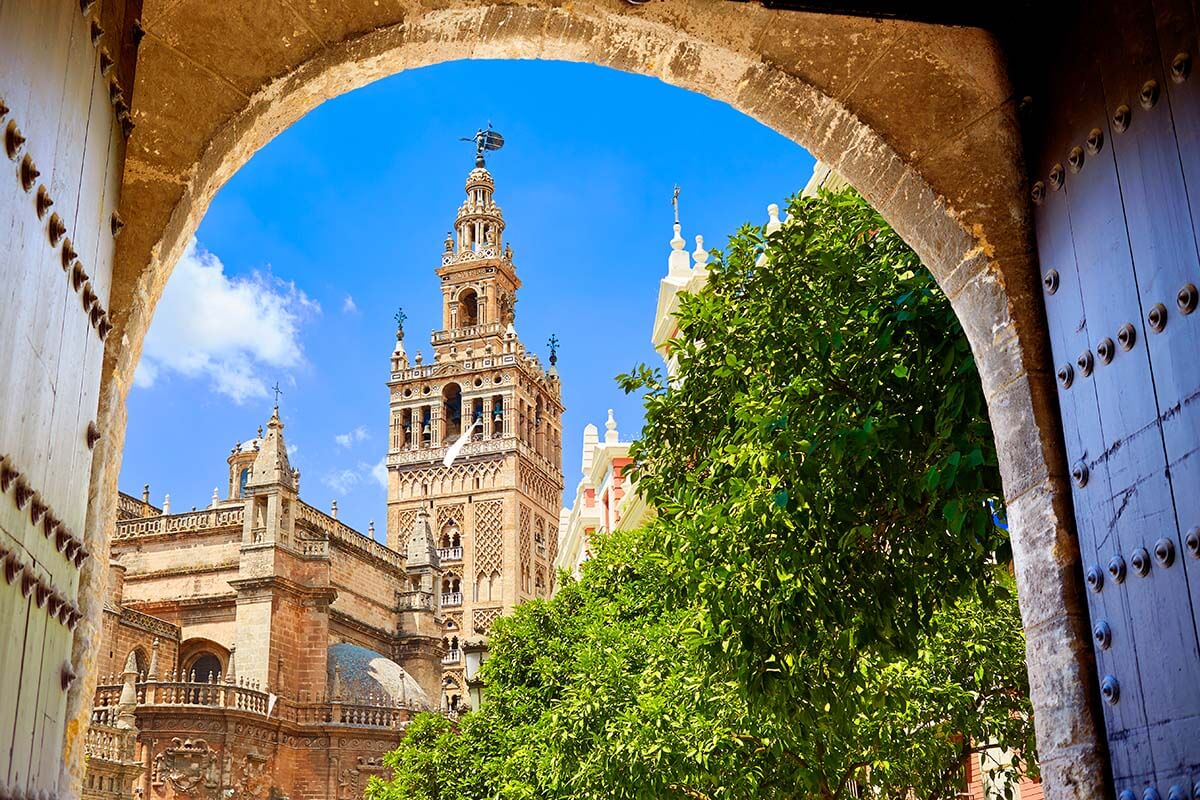
This site contains affiliate links, which means that we may earn a small commission, at no cost to you, for qualifying purchases. It supports the work that goes into keeping this content free. Thanks for reading! More info: Privacy Policy.
Traveling to Seville for two days and wondering what to see and how to plan your time? In this guide, we share a detailed 2-day Seville itinerary that will help you experience the very best that the city has to offer.
Seville (Sevilla) is the capital city of the Andalusia region and one of the most remarkable cities in Spain. It’s a unique melting pot of different cultures, architectural styles, and distinctive traditions, making a visit here really interesting and worthwhile.
Needless to say, there is a lot more to see and do than you could possibly cover in Seville in two days. On the other hand, two days is enough time to visit all the top spots (and even a few hidden gems), see a Flamenco show, and have plenty of opportunities to taste some delicious tapas.
Good to know: This itinerary is structured in such a way that it brings you to the main attractions at the best possible times and helps you avoid the biggest crowds. It’s not overly packed (not like our 1-day Seville itinerary) so you have more time to explore all the sights deeper, but a lot depends on your choices too. We also include a few local experiences and several less popular sights that will make your visit a bit more special.
To help you make the most of your trip, we also share tips on which tickets you absolutely have to pre-book in advance (Seville can be very busy!). In addition, we also created a map indicating all the places mentioned in this article, including some local recommendations on where to eat. See below!

Seville 2-Day Itinerary & Map
Here is an overview of our recommended itinerary for two days in Seville (you can find all the detailed information further below):
DAY 1:
- 8.30 – 9.30 AM: Plaza de España and Park Maria Luisa.
- 9.45 – 10.45 AM: Old town & cookies from a convent.
- 11 AM – 12.30 PM: Cathedral and Giralda Tower (timed-entry tickets or guided tour).
- 12.30 – 2 PM: Lunch.
- 2 – 2.30 PM: San Salvador Church (included with Cathedral ticket).
- 3 – 4 PM: Casa de Pilatos.
- 4.30 – 5.30 PM: Palacio de las Dueñas.
- 6 – 7 PM: Setas de Seville.
- EVENING: Calle Sierpes & dinner.
DAY 2:
- (8.30) 9.30 – 11 AM: Royal Alcazar (before-hours tour or timed-entry tickets).
- 11 – 11.30 AM: Archive of the Indies and/or Plaza del Cabildo.
- 12 – 2 PM: Lunch at Triana Market.
- 2.15 – 3 PM: Bull Arena.
- 3 – 4.30 PM: Golden Tower, Nao Victoria 500, and/or River Cruise (cruise options).
- EVENING: Flamenco & dinner (we opted for this amazing Flamenco & tapas tour, but there are many alternative options – more info further below).
IF YOU HAVE MORE TIME:
If you have 3-4 days in Seville, you could spend more time exploring the city (and there’s a lot to see indeed). However, if you want to see more of the beautiful Andalusia region, consider one or several day trips nearby. Here are the most popular choices for a day trip from Seville: (1) White Villages and Ronda, (2) Alhambra in Granada, and (3) Caminito del Rey hike. No matter which one you choose, it will make your visit to Seville so much more memorable!
As promised, here is a map indicating all the places mentioned in this guide, as well as some additional restaurant recommendations. Further below, you can find a detailed 2-day Seville itinerary with more information and tips for all the sights and attractions.
How to use this map: Use your computer mouse (or fingers) to zoom in or out. Click on the icons to get more information about each place. Click the arrow on the top left corner for the index. Click the star next to the map’s title to add it to your Google Maps account. To view the saved map on your smartphone or PC, open Google Maps, click the menu and go to ‘Your Places’/’Maps’. If you want to print the map or see it in a bigger window, click on ‘View larger map’ in the top right corner.
Planning Info & Tips
While you can easily visit the Cathedral and Royal Alcazar on the same day, it can be quite tiring and overwhelming. So with two days in Seville, we recommend visiting these two major sites on different days. But you can easily adjust this itinerary and see them both on the same day. In fact, there are many guided tours that visit both sites together, in about 3 hours.
TIP: If you are not interested in guided tours, this Seville Super Combi includes tickets to the main attractions and allows you to choose all time slots in one booking.
There are countless ways to adjust this itinerary (and everything is rather close by!), so feel free to do so based on your interests and schedule. But let me tell you why we recommend it as it is.
First, depending on the season, the Cathedral opens much later than Royal Alcazar, so it’s easier to start your first day there even if you only arrive in Seville in the morning. Second, I wouldn’t recommend visiting Alcazar and Casa de Pilatos as well as Palacio de las Dueñas on the same day. You’ll appreciate these sights much more if you see Alcazar after and not before them.
Please also note that the hours are only indicated for your reference – based on the normal opening hours, which might be different when you visit. Plus, depending on the options that you choose, you may have to plan a bit more (or less) time at some of the attractions.
Good to know: Seville is the warmest city in Spain and it gets VERY hot in the summer. Most shops and restaurants are closed in the afternoons, some tourist sights are open. But if you are traveling in the warmest months, don’t pack your afternoon itinerary too much because you may decide to take a siesta as well. For that, make sure that you stay centrally and that your hotel has a pool! Radisson Magdalena Plaza (€€€€€), Hotel Amadeus (€€€€), and Hotel Doña María (€€€) are all excellent options.
There are so many other factors to consider too; these are just the main ones. Further below, you can find more information and planning tips in our detailed guide about all the places recommended in this itinerary.
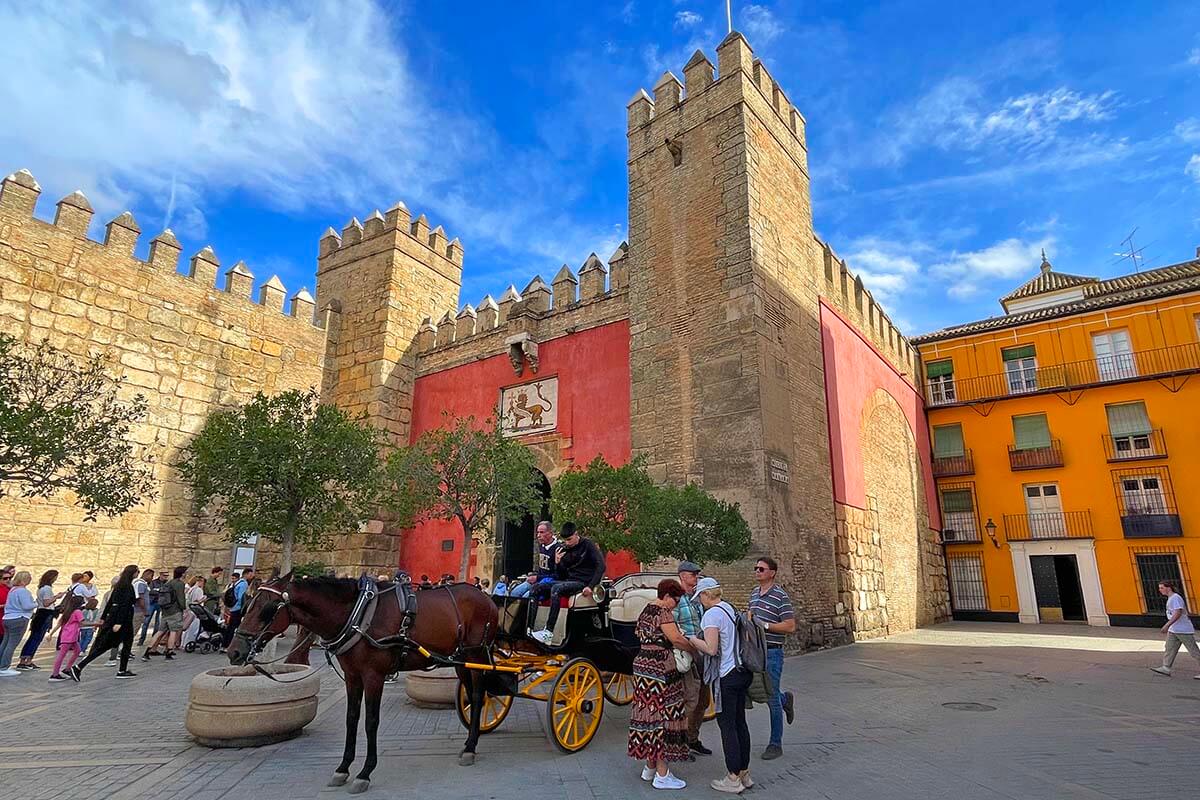
Below is a detailed itinerary for two days in Seville:
DAY 1: Old Town, Cathedral, Palaces & Setas de Seville
Here is what your first day in Seville could look like:
Plaza de España and Park Maria Luisa
8.30 – 9.30 AM.
Plaza de España is one of the most famous landmarks of Seville. This monumental square was built for the Ibero-American Exposition of 1929 and has been awing visitors ever since.
Its architecture is very impressive – with beautiful buildings and an arcade gallery, azulejo tiles, and four bridges spanning a 515-meter-long canal, where you can even row a boat. Just to be clear, there is nothing you see on the boat that you wouldn’t see otherwise – you can walk along the canal too.
It’s unlikely that boat rental will be available early in the morning, but in general, the morning is one of the best times to visit Plaza España. There is hardly any shade on the square and it can get very hot during the day. Plus, there will be fewer people, allowing you to admire and explore this unique monument to the fullest.
Adjacent to the square, you’ll find Parque de Maria Luisa, Seville’s most beautiful park. There are many monuments (some also dating from the 1929 Expo) and interesting features to see here. You could just walk around for 15-20 minutes or spend an hour here or even more. There is also a bike/tandem/cyclobus rental at the park.
Planning info: The square and the park are free to visit. In general, they are open to the public from 8 AM. The boats and the bikes might only be available from 10 AM though, so if you are absolutely interested in any of those options, you’ll have to amend the itinerary and come here at another time.
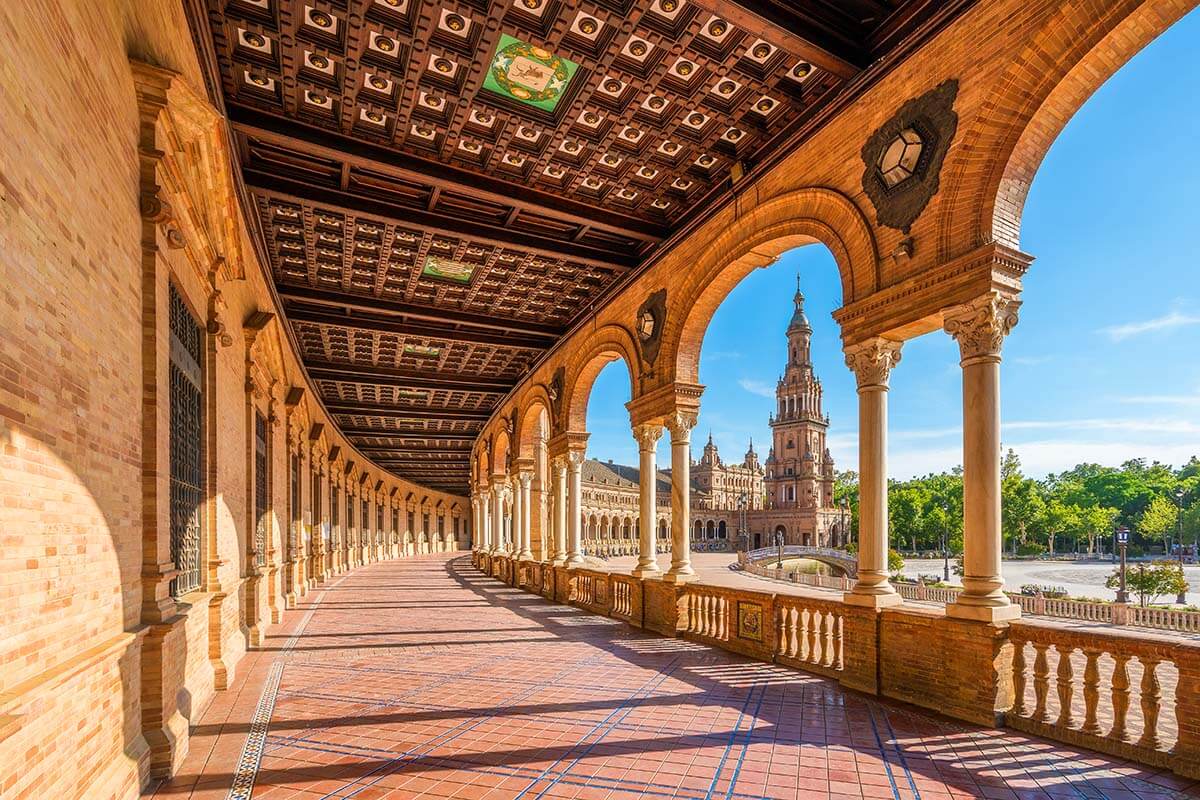
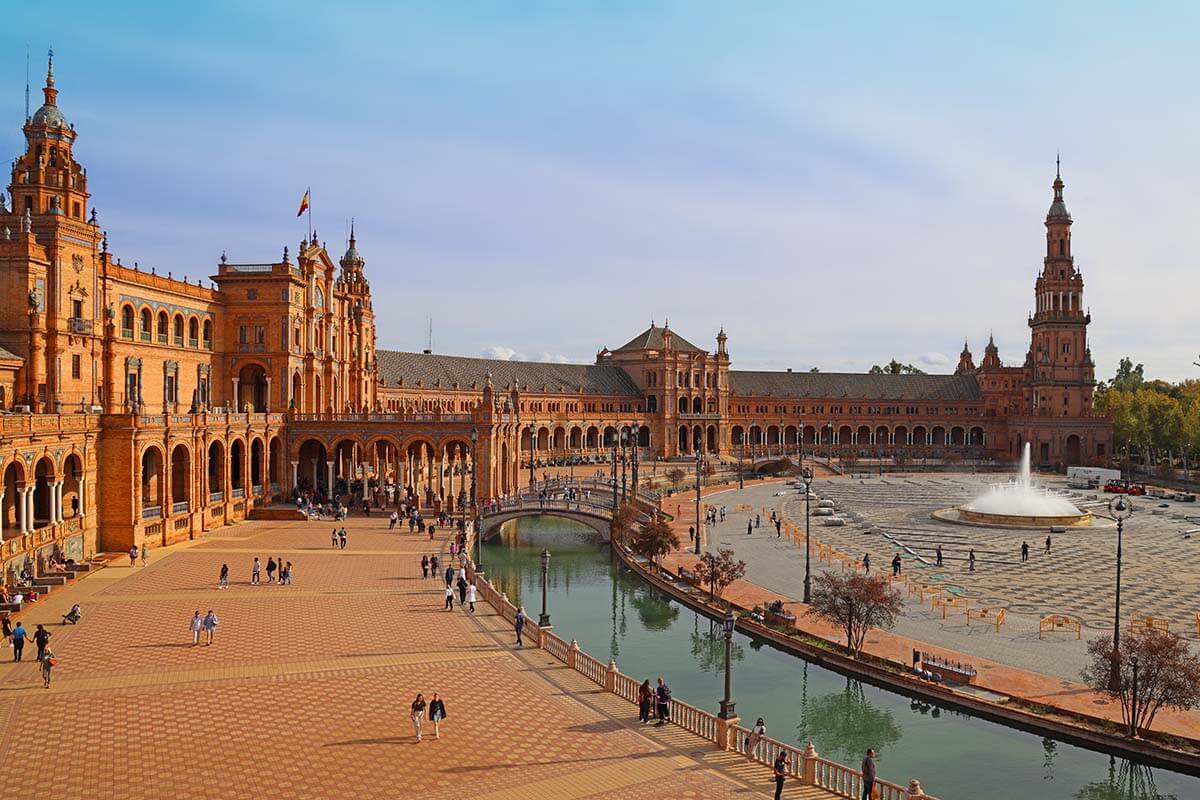
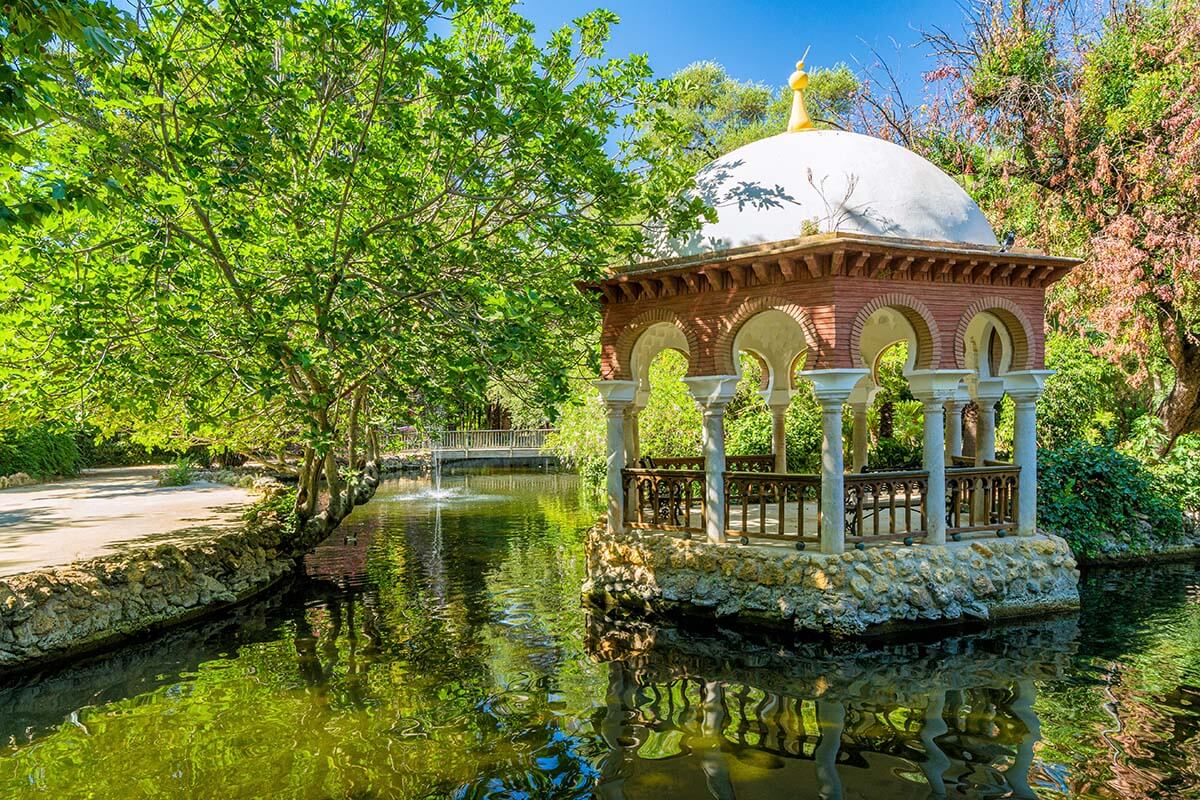
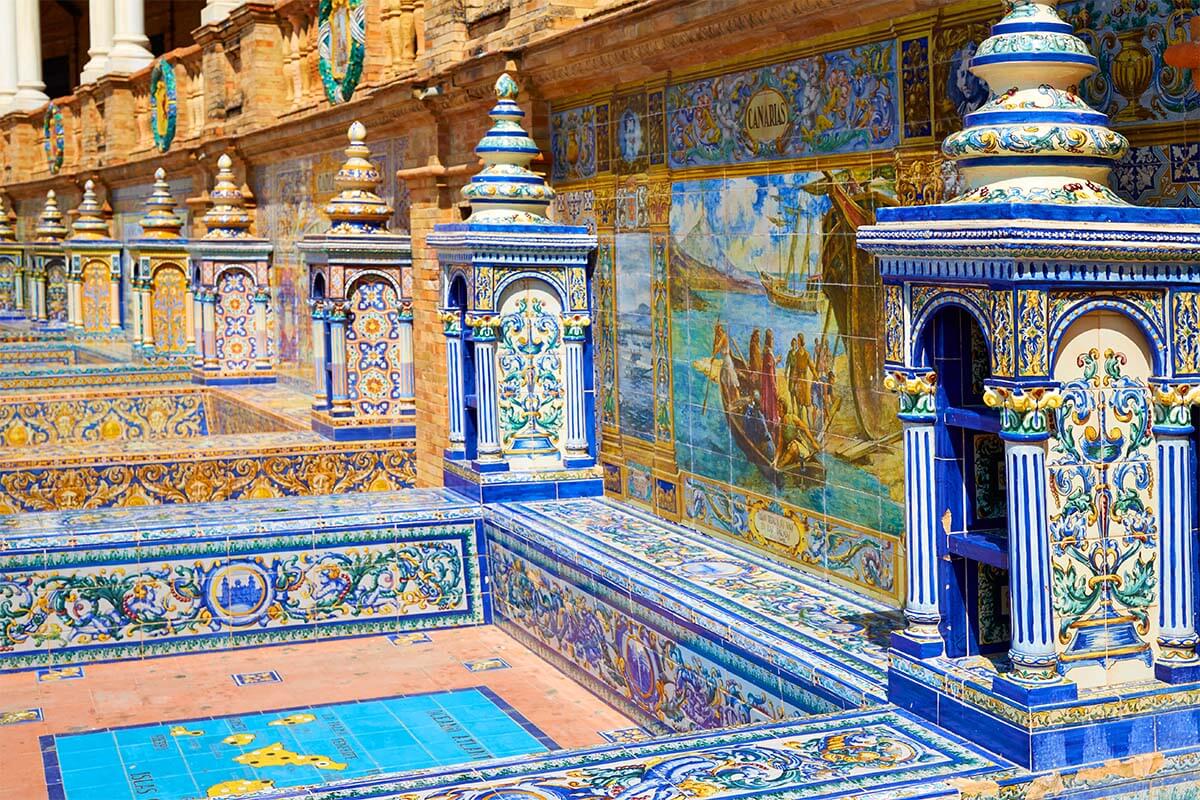
Seville University, Murillo Gardens, Barrio de Santa Cruz
9.45 – 10.30 AM.
Next, head to the historic town center. You can easily walk there in about 15-20 minutes, but there are taxis and trams available too. You will also see horses with carriages parked at the park entrance which could also bring you to the old town.
We recommend walking. On the way, you could stop by the former Royal Tobacco Factory of Seville (now Seville University) and walk through the beautiful Murillo Gardens.
In the old town, explore Barrio de Santa Cruz, the old Jewish neighborhood of Seville. It’s located to the east of the Cathedral and the Royal Alcazar. This lovely area is a labyrinth of narrow streets and charming squares. It’s home to many beautiful historic buildings and tourist sights such as Hospital los Venerables, La Casa del Flamenco, and Casa de Salinas, to mention just a few.
Depending on your interests, you could visit one or the other place; most will be open already. Otherwise, simply walk around and sit down for a cup of coffee and some churros at one of the many restaurants.
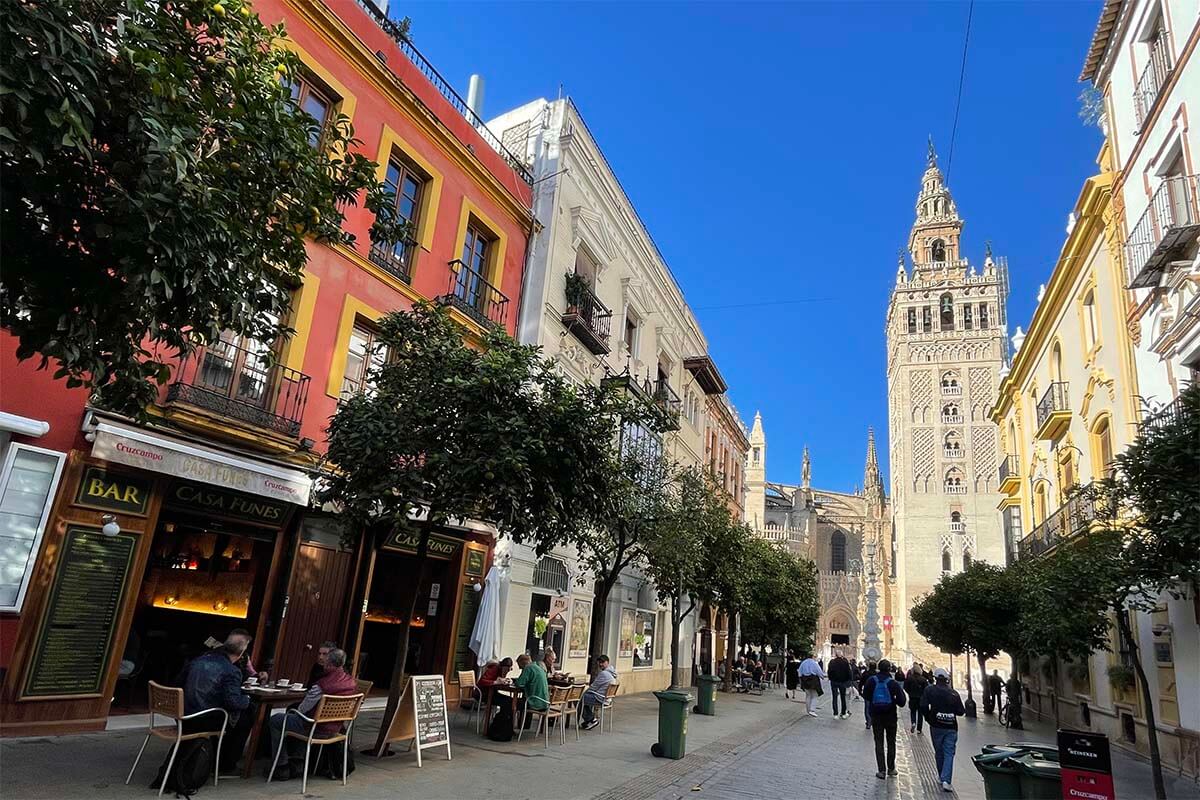
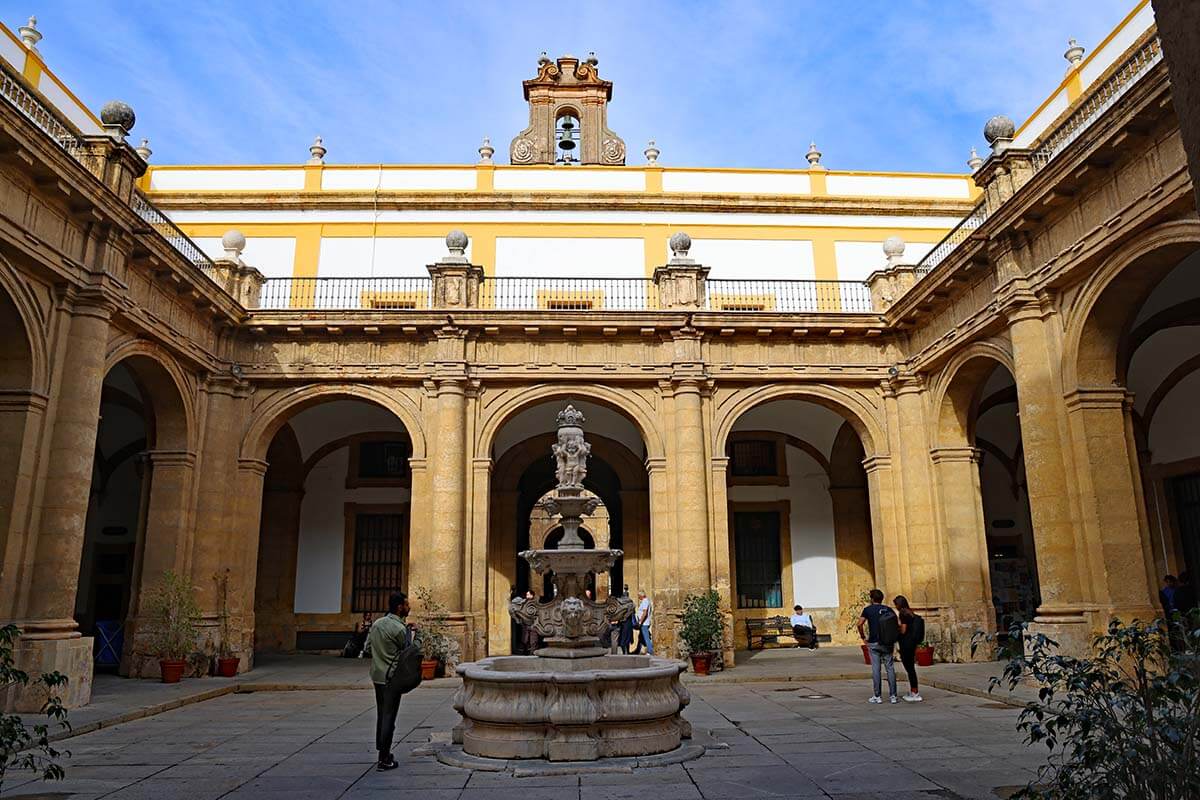
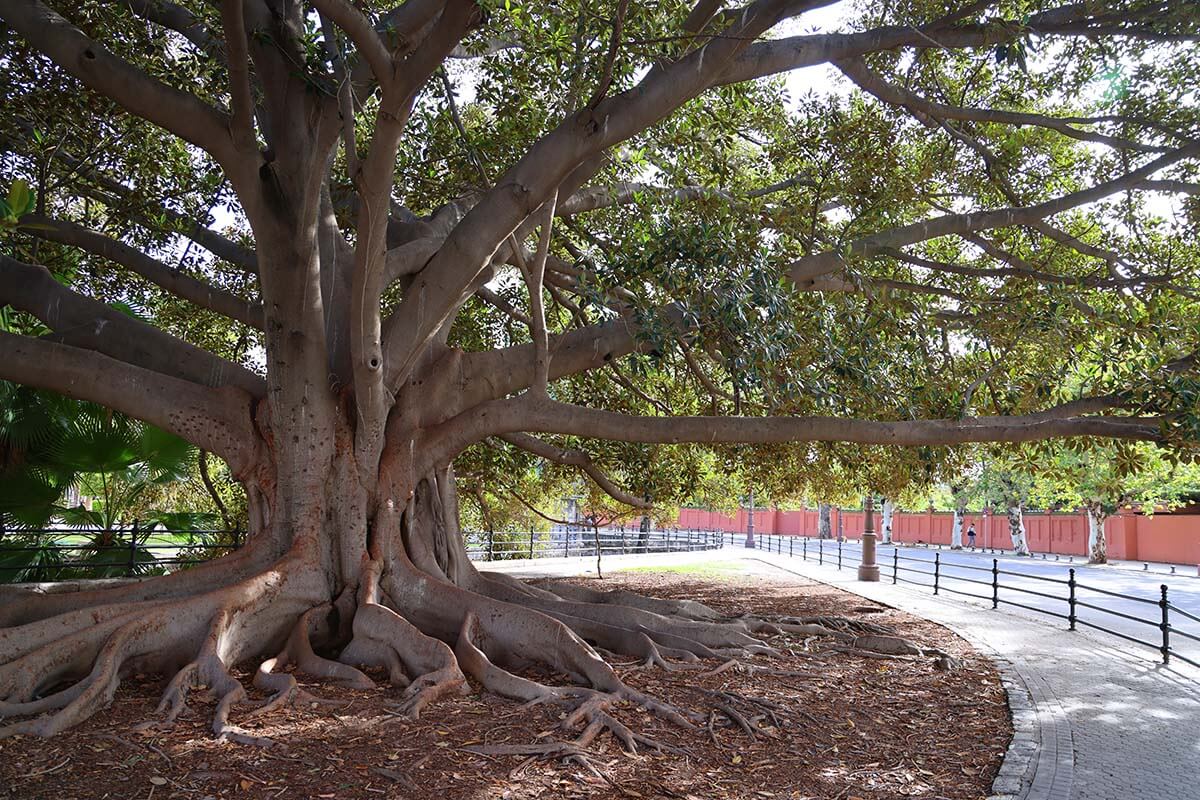

Cookies from a Convent
10.30 – 10.45 AM (OPTIONAL).
If you are looking for a truly local experience, you have to get some traditional Sevilla sweets from a convent. This century-old Seville tradition originated around Christmas when people used to buy cookies and sweets made by nuns for the holidays. Nowadays, it helps to support the monasteries.
There are several convents where you can go for some local delicacies, but for this itinerary, we recommend Convento de Madre de Dios, which is the most centrally located of them all. We indicated it on our map.
The entrance is not very well signposted but using Google Maps, it’s not difficult to find. Once inside, you will see a little window to your left and a bell that you can ring if there is nobody there. The convent is usually open from 10 AM to 1.30 PM daily except on Sundays. Bring cash!
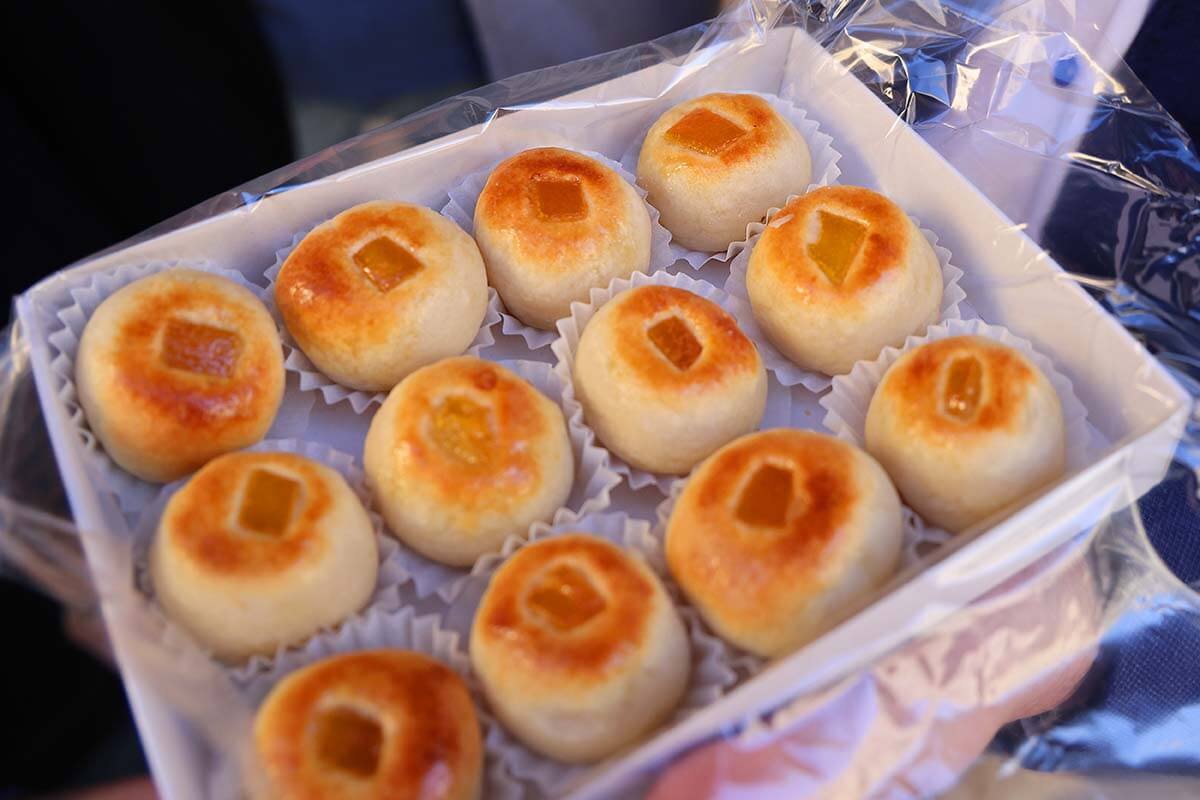
Seville Cathedral & Giralda Tower
11 AM – 12.30 PM.
The impressive Seville Cathedral and its famous Giralda Tower are absolute must-sees, no matter how much time you have in the city!
Built in the 15th century on the site of an old Mosque, Seville Cathedral is the largest Gothic church in the world. It’s also the 3rd largest Catholic church in Europe, after St. Peter’s in the Vatican and Duomo in Milan. Let’s just say that it’s absolutely impressive – both on the outside, as well as the interior.
The main highlight inside is the monumental grave of Christopher Columbus. But there is a lot more to see, including the stunning altars, stained glass windows, and dazzling Gothic pillars and ceilings.
Another must-see is the Cathedral’s bell tower, La Giralda. You will notice that this tower has Moorish architecture. It was part of the old mosque and was kept simply because it was so beautiful.
You can climb to (almost) the top for amazing 360° views of the city. The climb is not difficult with wide passages rather than narrow stairs like in most bell towers. However, it’s often so busy that the entire climb is one long queue… Plus, the views at the top are obstructed by a metal security net, so taking pictures is difficult, but if you just want to enjoy the views (and the sounds of the bells – every 15 minutes!), then it’s worth it.
Planning info: You’ll need a timed entry ticket for a visit to the Cathedral and Giralda. So while booking it, you can immediately see when it’s open on your travel dates. For this itinerary, we recommend booking a time slot at around 11 AM.
TIP: When booking a ticket, you can also get an audio guide – it can be a good idea because there is a lot to see inside. Also, if you want to visit the tower, do it immediately after you pass the security check. When it’s busy, they give priority to people entering with timed tickets from the outside. You can visit the church itself after you come down from the tower.
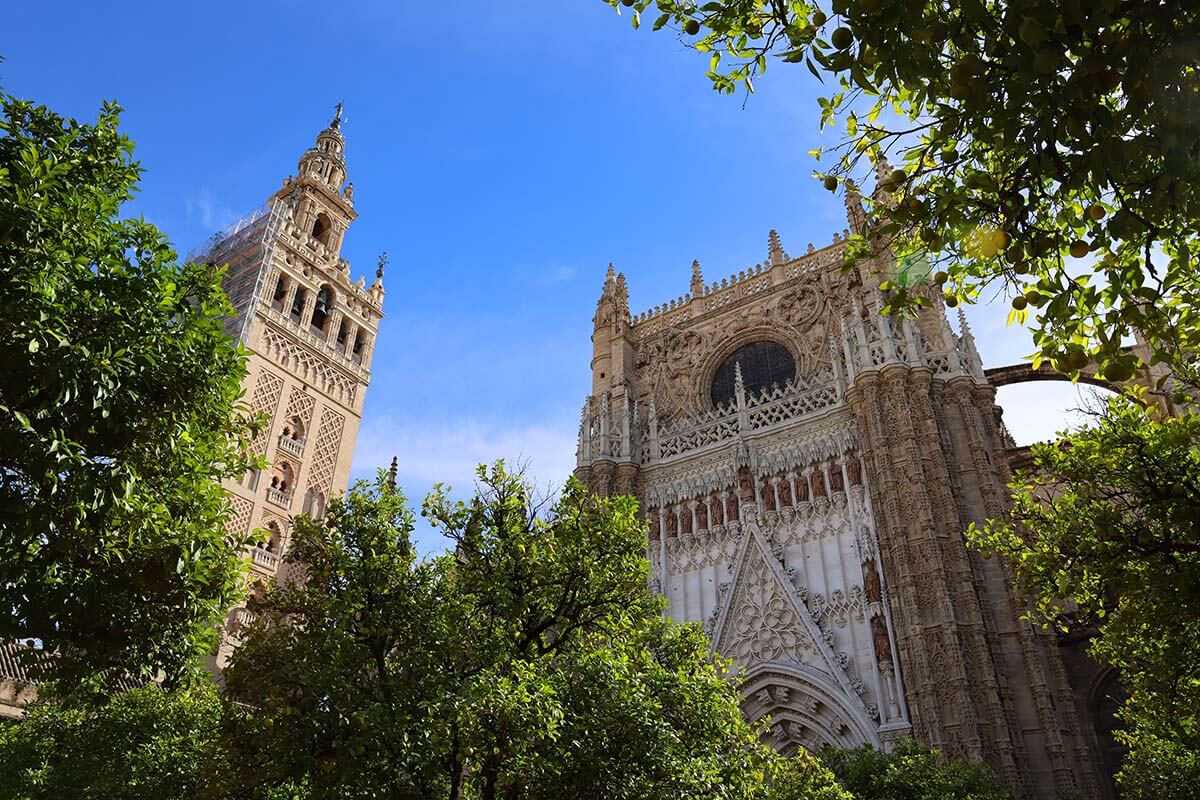
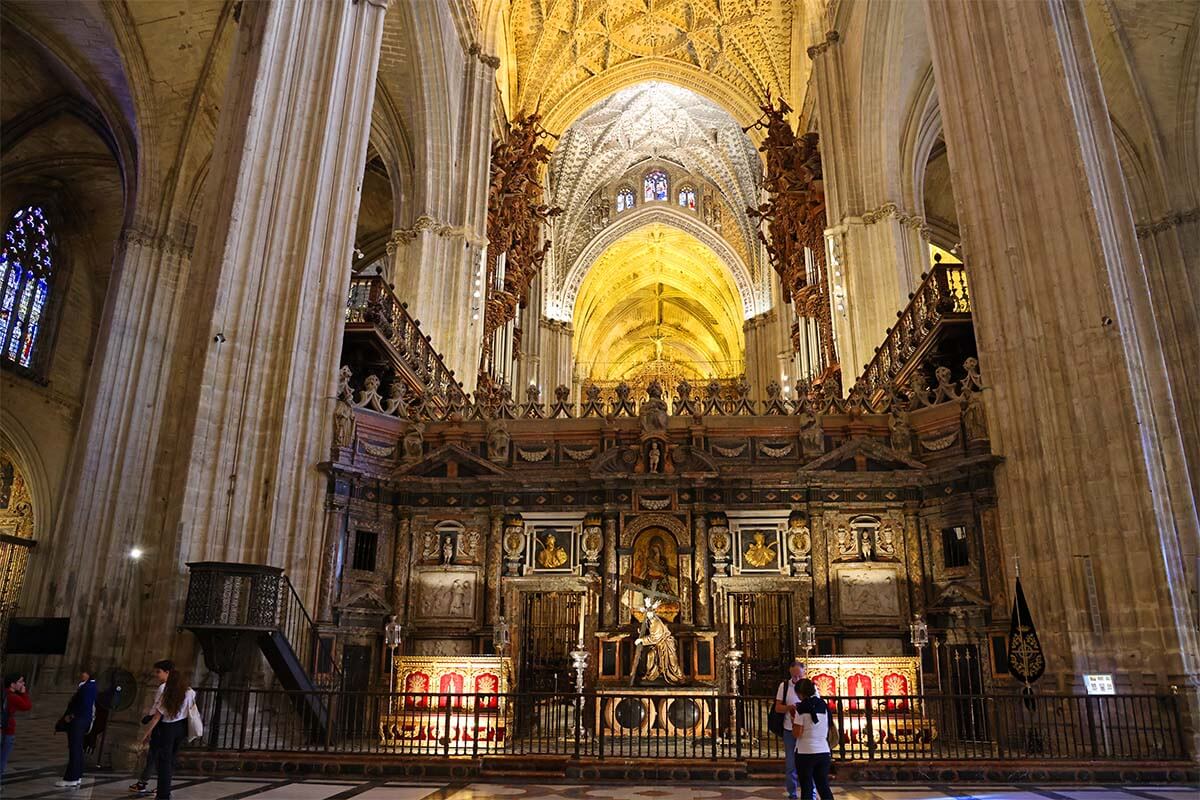
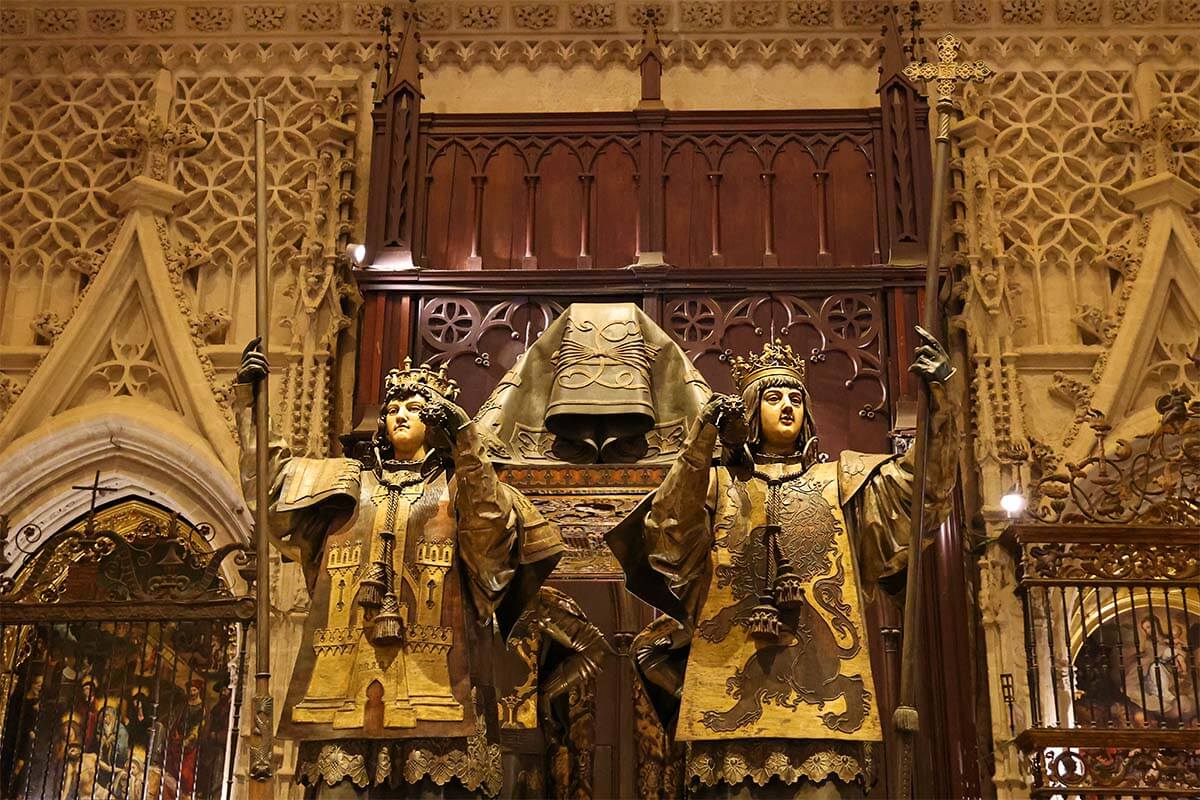
Alternative: If you are looking for a more unique experience (and don’t mind spending 2 hours extra), you can also visit the rooftops of the Cathedral. You can only book this tour via the official website and have to stay with the guide at all times. There are usually just one or two tours a day and you have to book well in advance.
After the tour, you can visit the Cathedral and Giralda Tower on your own, so you’ll need at least 3 hours if you choose this option.
We did this rooftop tour and while the views were absolutely amazing, we were exhausted from all the slow walking during this tour (you spend way too much time standing still and listening to the guide). And it wasn’t even warm; I can’t imagine doing this in the summer… We have done many other cathedral rooftop tours in Europe and they are always unique and well worth it, but the one in Seville was by far the slowest and the longest of them all.
TIP: If you ever travel to Italy, you can visit the rooftop terraces of the Duomo in Milan much more easily and without a guide. Also the rooftops of Siena Cathedral are among the most interesting we have seen. In Florence, there’s also an amazing tour with exclusive access to the Duomo terraces.
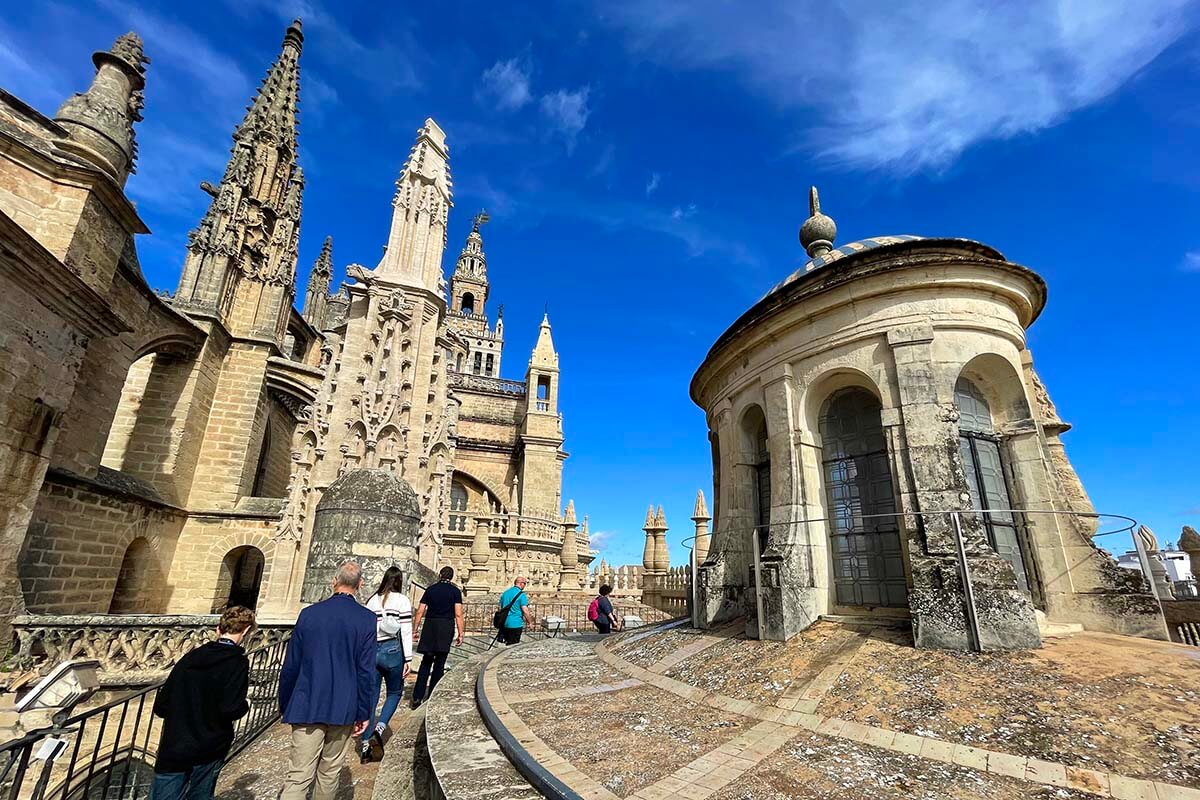
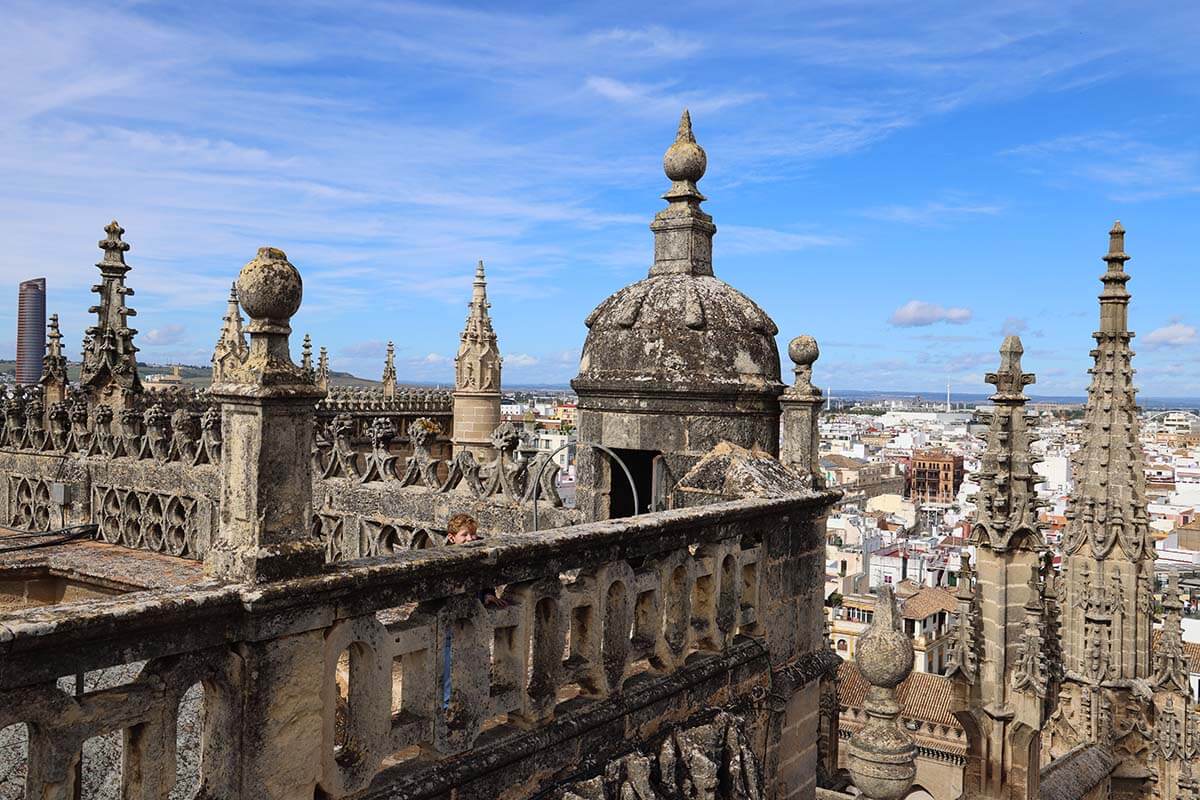
Lunch
12.30 – 2 PM.
For lunch, we recommend simply finding a restaurant in the vicinity of the Cathedral. There are so many nice places for tapas. Just be sure to check the reviews (we usually use Google Maps) so that you can avoid tourist traps.
We indicated a few restaurant suggestions on our map as well. Some good choices in the area include Bar Casa Morales and Taberna Coloniales to the west of the Cathedral (and there are many, many more).
Planning info: Since the Spanish tend to eat later, some restaurants don’t open until 1 PM. However, there are usually plenty of others that are open earlier. If you go to eat around noon or a bit before 1, it’s much easier to find a table at good, local restaurants.

San Salvador Church & Square
2 – 2.30 PM.
The Church of San Salvador (Iglesia Colegial del Divino Salvador) is one of the most beautiful churches in Seville. It’s the second-largest church in the city, but totally different than the Cathedral.
For starters, it was built a few centuries later in the Baroque style. The church has a bright red exterior and a colorful dome which is difficult to see from close-by, but you will see it in Seville’s skyline from many other places in the city. The opulent interior is worth seeing too, especially the extravagant gilded altars.
This church is located on a beautiful square, Plaza del Salvador, where you will also find another remarkable church, Iglesia de la Virgen de la Paz. With its lavishly decorated facade and two towers, it looks more like a palace than a church.
Planning info: The Church of San Salvador is open daily, on Sundays only in the afternoon. The entry is included with the Cathedral ticket. Iglesia de la Virgen de la Paz is usually open until 2 PM and then again late in the afternoon, but visiting inside is not an absolute must.
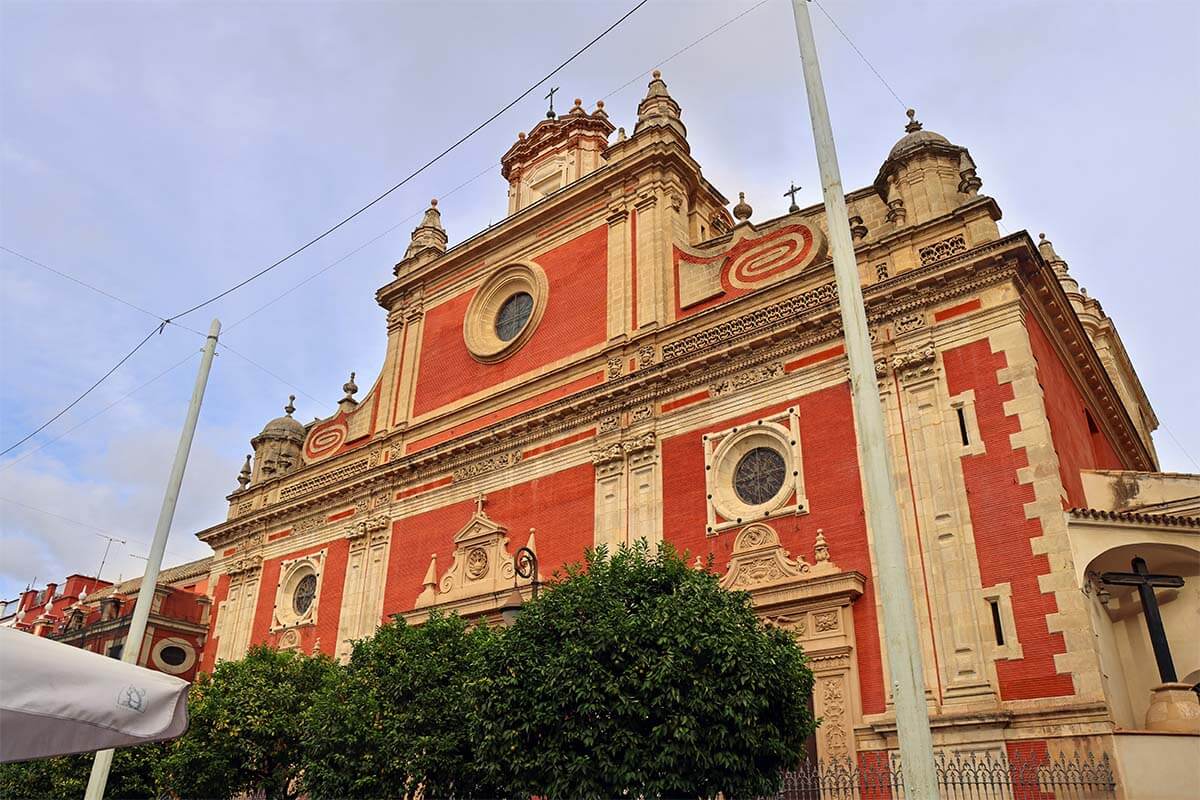
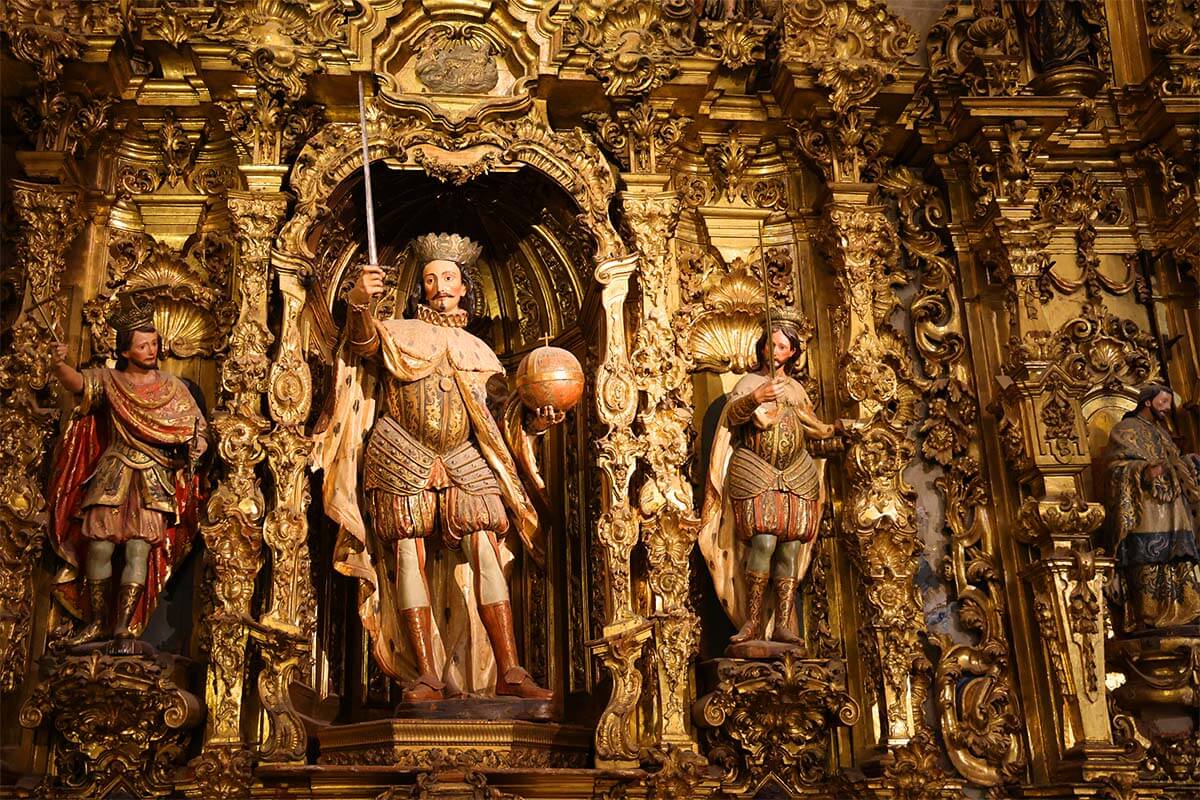

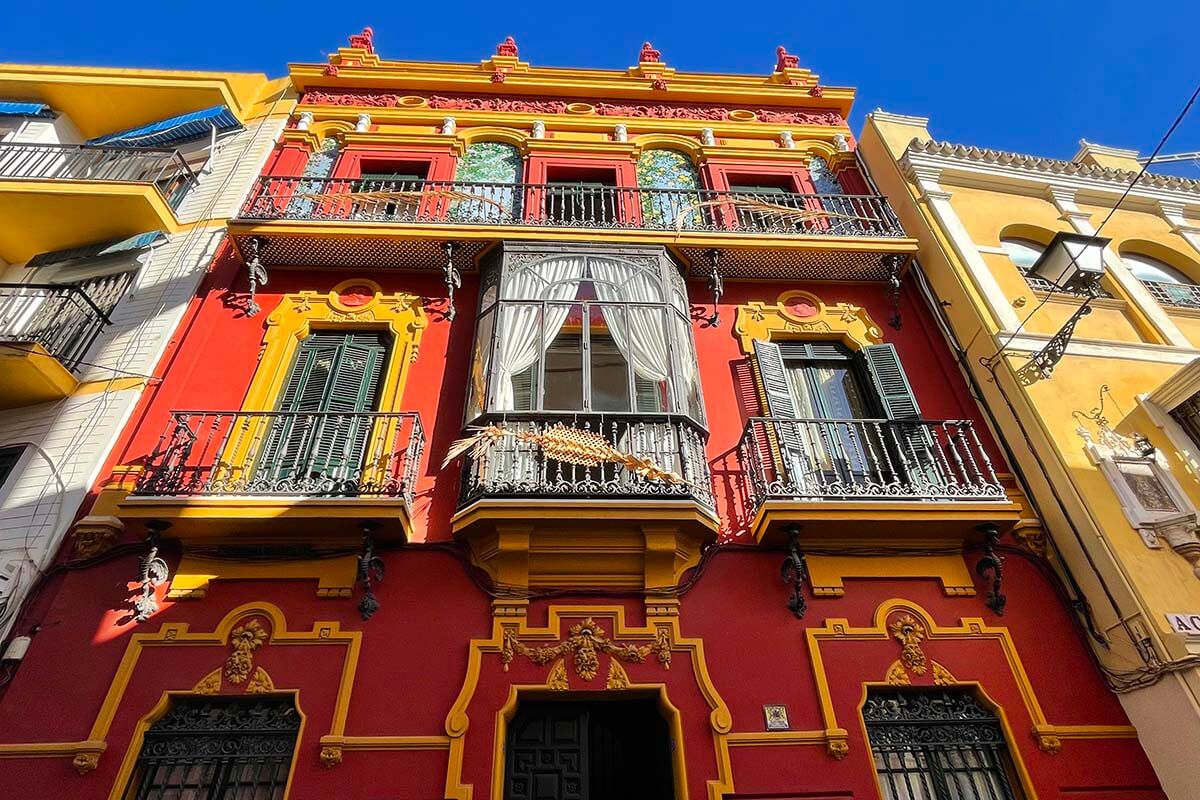
Casa de Pilatos
3 – 4 PM.
Casa de Pilatos is one of the most beautiful palaces in Seville. Built in the 15th-16th centuries, this was the Palace of the Governors of Andalusia, the family of Enríquez de Ribera.
Over the years, the family has expanded the house by purchasing the grounds and properties around it. The property became the biggest private residence in the city, with beautiful gardens, impressive courtyards, and a maze of rooms and hallways spread over several buildings. It is one of the finest examples of a typical Andalusian palace.
Nowadays, Casa de Pilatos is the residence of the Dukes of Medinaceli and a museum managed by the Ducal House of Medinaceli Foundation.
It’s difficult to describe this place as it has such an unusual mix of architectural styles. From the late-medieval Gothic and Mudéjar-style ornamentation and decoration (post-Islamic Iberian architecture) to the early Renaissance styles with Italian influence – it’s a unique blend, to say the least. But Casa de Pilatos is very impressive and well worth seeing.
Planning info: You can get tickets for Casa de Pilatos online in advance or buy them on the spot. Depending on how busy it is, however, you may not be able to visit without advance reservation. It wasn’t an issue when we visited in November, but I read that some people were not able to visit because it was sold out… Anyway, regular tickets include a visit to the ground floor and an audio guide.
You can quickly walk through the palace in 15-20 minutes, but if you want to explore a bit deeper and listen to the audio guide, count at least 30-45 minutes inside.
The upper floor can only be visited with a 1-hour guided tour. If interested, you can book a tour for a specific time slot on the official site or simply see if there is one available and decide when you get there. We only visited the ground floor so I’m not sure whether the first floor is worth it. For us, it was more than enough since there’s only that much one can do with just two days in Seville…
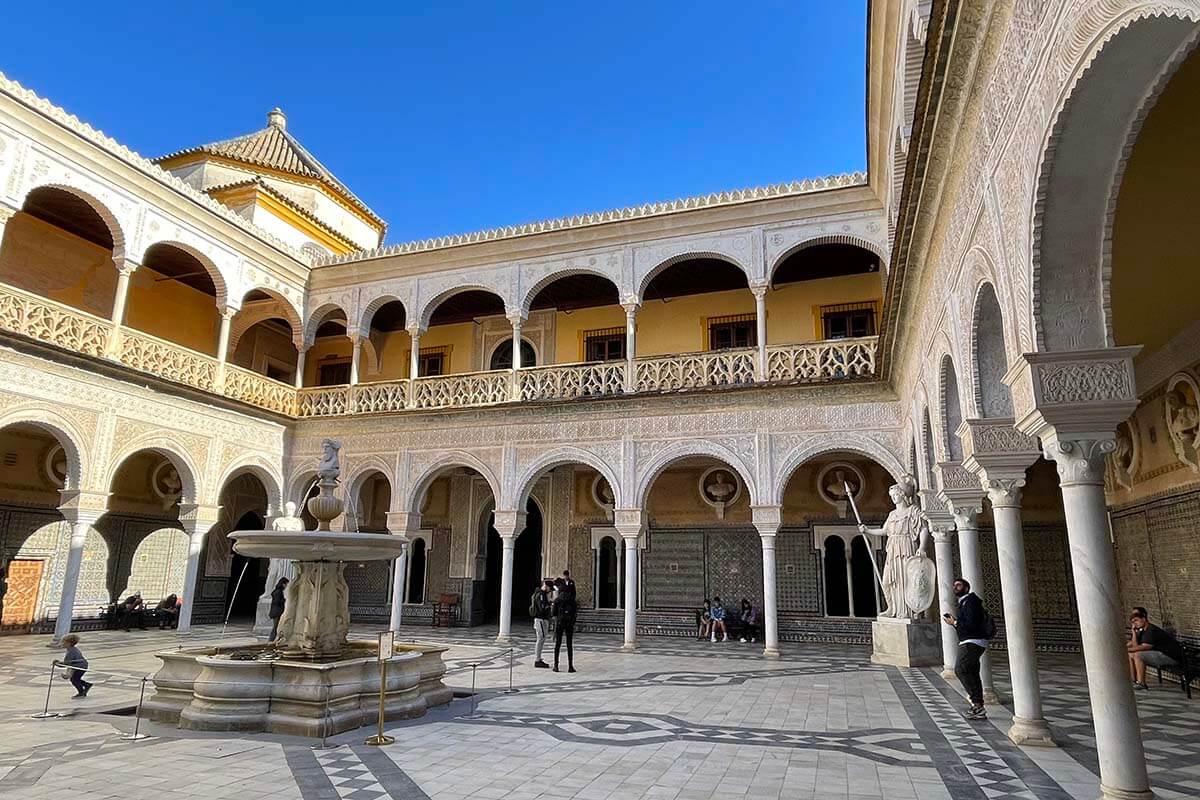
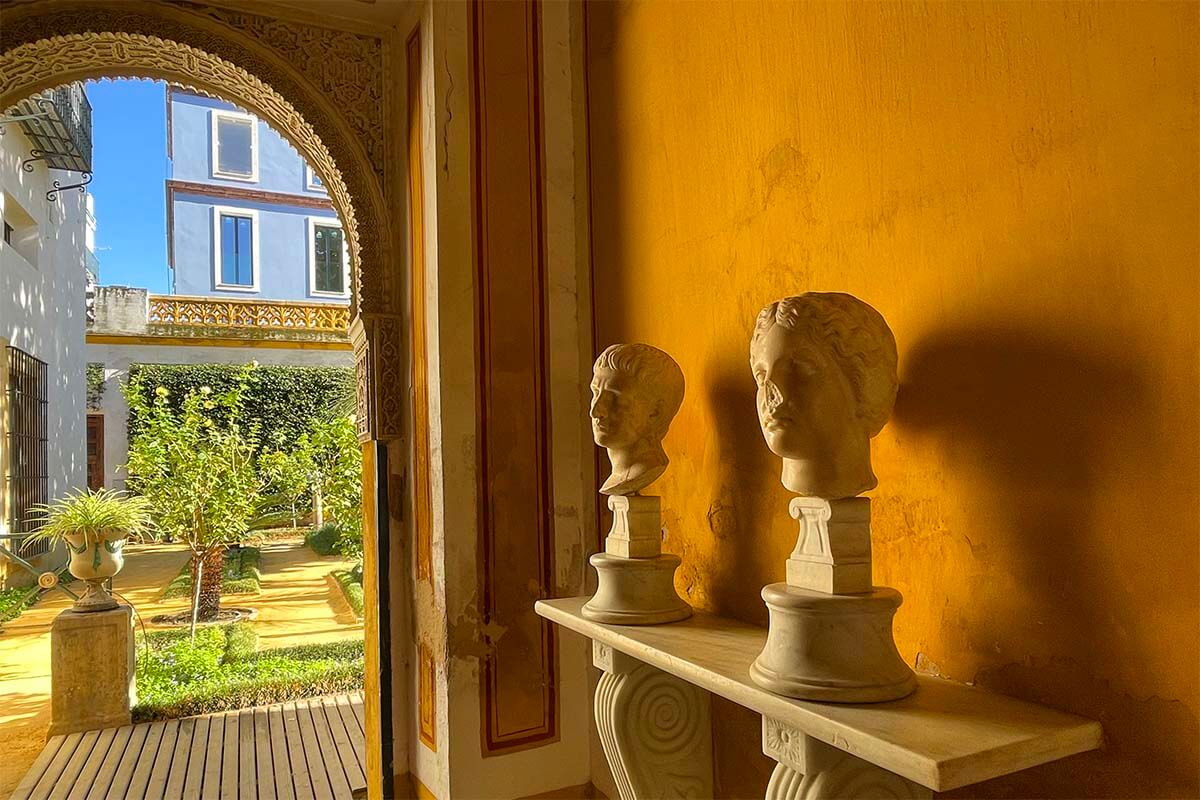
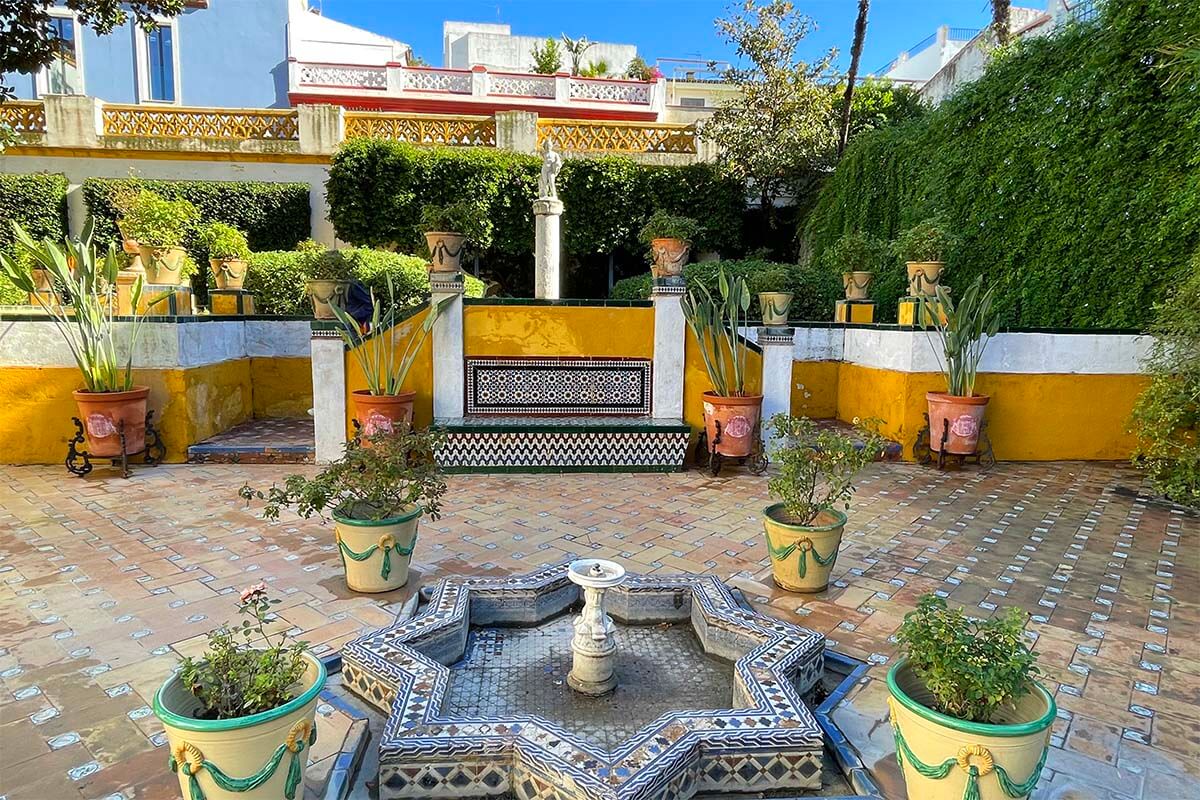
Palacio de las Dueñas
4.30 – 5.30 PM.
Just 10 minutes walk from Casa de Pilatos, you will find another impressive Andalusian palace, Palacio de las Dueñas. This private palace was also built in the same period (15-16th centuries) and its architecture is also a mix of Gothic-Mudejar era and the Renaissance styles.
Las Dueñas Palace is not as popular as Casa de Pilatos, but it’s well worth a visit too. Because it’s located a bit further away from the main sights in Seville, it’s not as busy here and if you are lucky to visit when it’s quieter, it feels a bit like a hidden gem.
The architecture is really nice and the courtyard gardens are simply beautiful. Depending on the season, you may also admire the pink flowers covering the facade of the building. The interior oozes a luxuriously royal atmosphere, with the rooms recreated as they would have looked when the palace was lived in. There is also a very diverse collection of artworks.
Planning info: You can get tickets for Las Duenas Palace online in advance or buy them on the spot (which could mean a longer wait time). Tickets include an audio guide. Also here, you can quickly walk through in less than half an hour, but they recommend at least 45 minutes inside. Keep in mind that the palace closes at 6 PM and the last entry is at 5.15 PM.
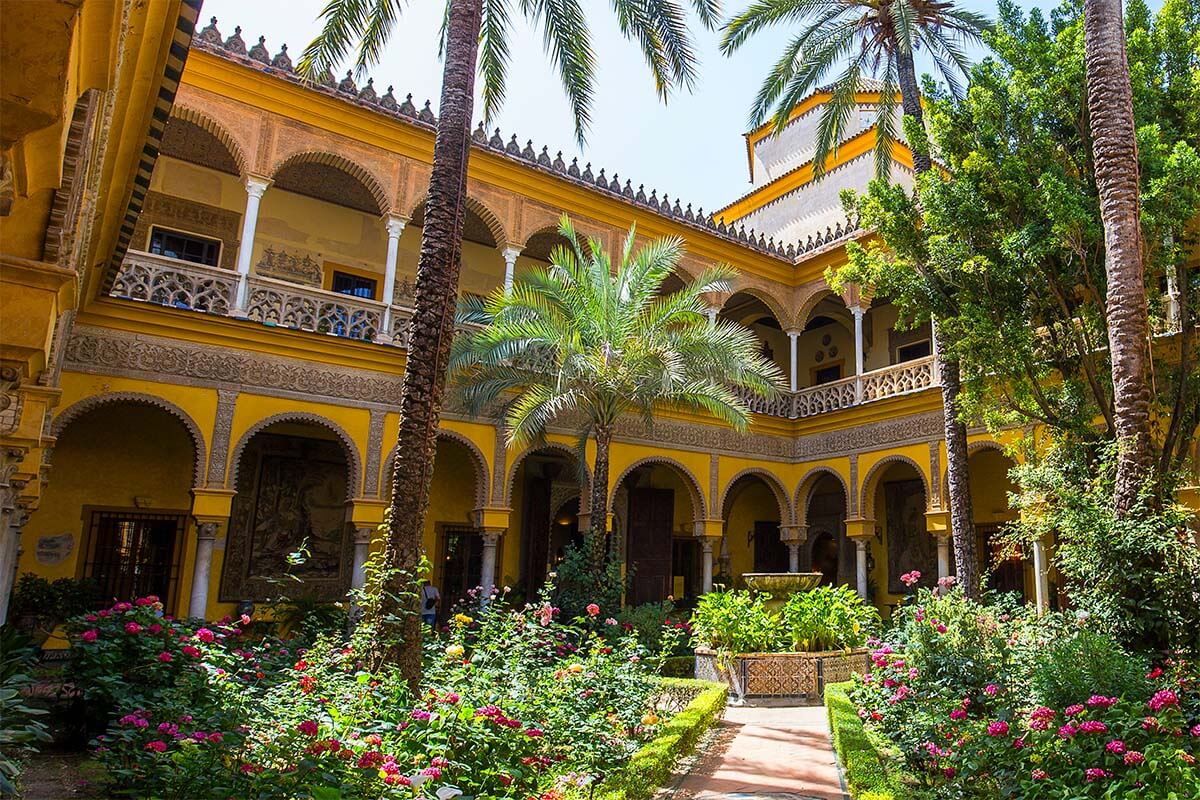
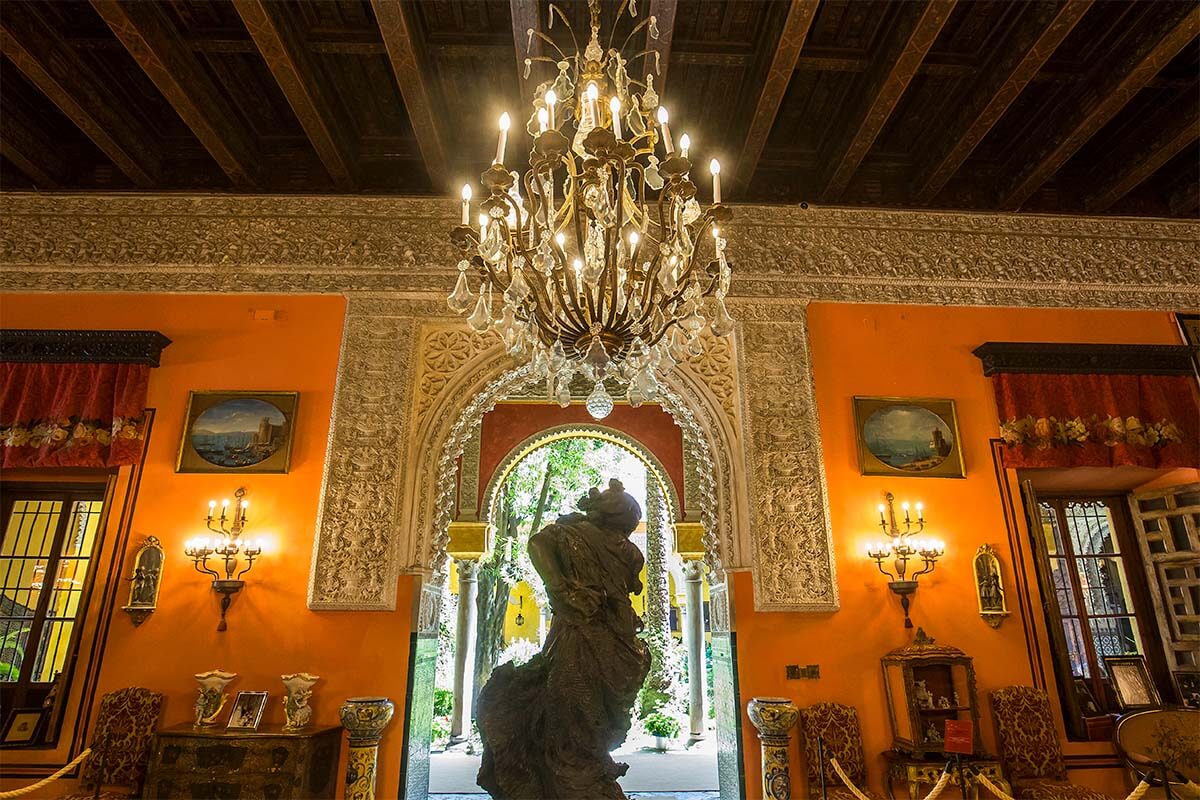
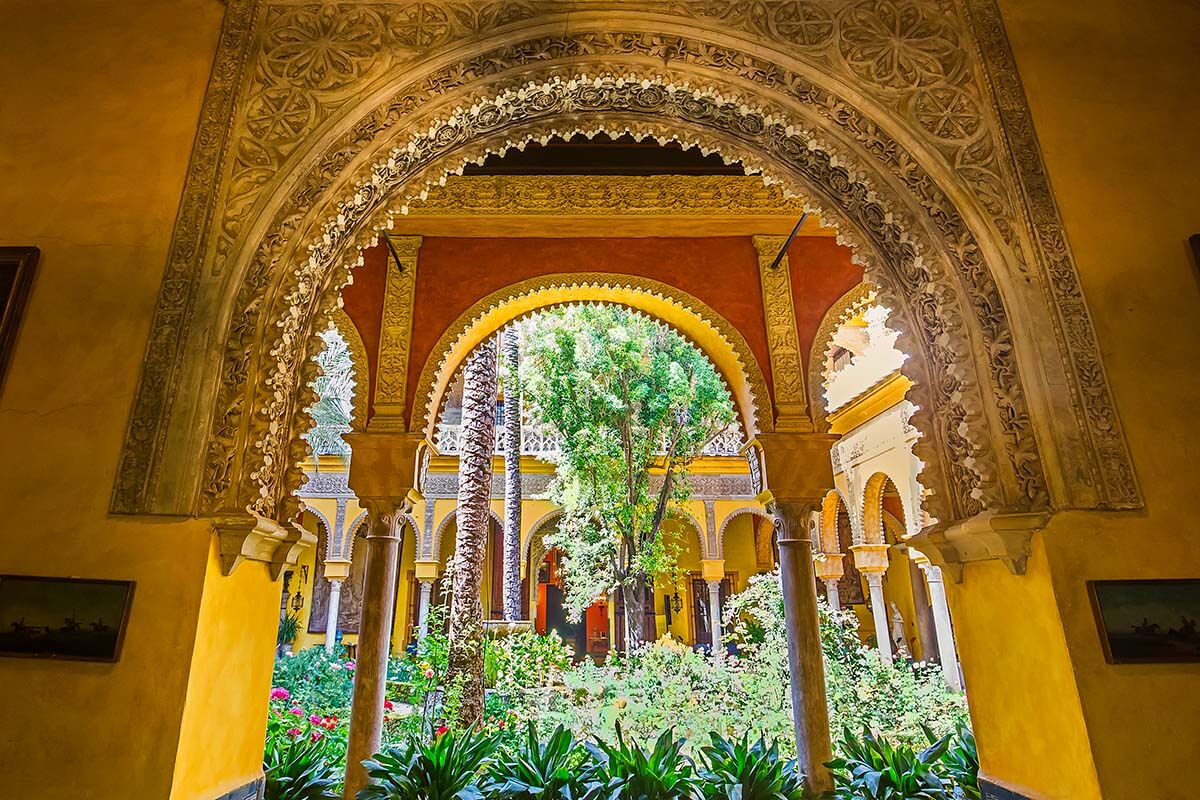
Setas de Seville
6 – 7 PM.
Setas de Seville, aka Metropol Parasol, is a unique contemporary landmark that quickly became one of the must-sees in the city. Built over an ancient archeological site with the ruins of a Roman house (now Antiquarium Museum), the contrast with the modern architecture couldn’t be bigger. Yet somehow it fits together.
If you have the time and interest, you could also visit the archeological site, but the main reason to come here is definitely the viewing platform of Setas de Seville. The 360° panoramas from the top area really nice, offering an elevated viewpoint of the entire city center.
Plus – depending on the time of the year – you can enjoy a sunset from above, or enjoy a beautiful LED show ‘Aurora’ which starts the moment it gets dark.
The ‘Parasol’ is a large modern wooden structure with a viewing platform on top. You can see it from the outside just like that, but you will need a ticket to visit the rooftop. The tickets also include a ‘Feeling Seville’ experience, which is a very nice short movie about the city.
Planning info: The Setas de Seville viewing platform is open until past midnight, so it’s very simple to fit it into any Seville itinerary. You can also come here after dinner if you prefer.

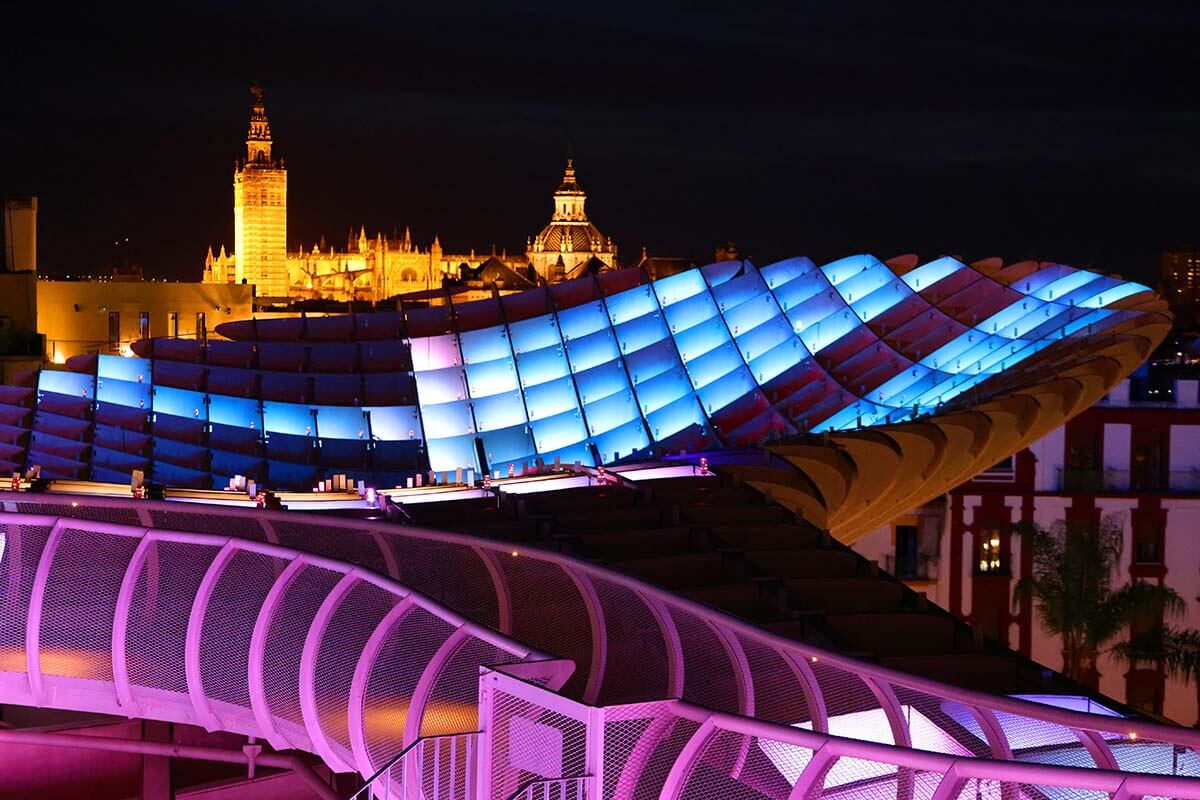
TIP: If you absolutely want to visit at a specific time, it’s best to reserve tickets on the official website in advance. While you can just get tickets on the spot, they only allow a certain number of people inside, so if it’s busy, you may have to wait a while until you can get in.
We had to wait for the tickets for almost half an hour, plus another half an hour before we could go inside. As we were waiting, the time slots that were available online when we arrived got filled up and we got a much later slot.
We could have easily gotten earlier tickets by simply booking via our smartphone instead of standing in line, but we thought that a ticket bought on the spot would give you immediate access, but it turns out that’s not the case. (Don’t always trust online forums :)).
Next time, I would try booking in advance, even if just on the day itself while walking there. That way, you can avoid the queue at the ticket desk and can see which time slots are still available. And if you have to wait a bit longer, you can simply sit down for a drink and relax a bit rather than waste your time queuing.
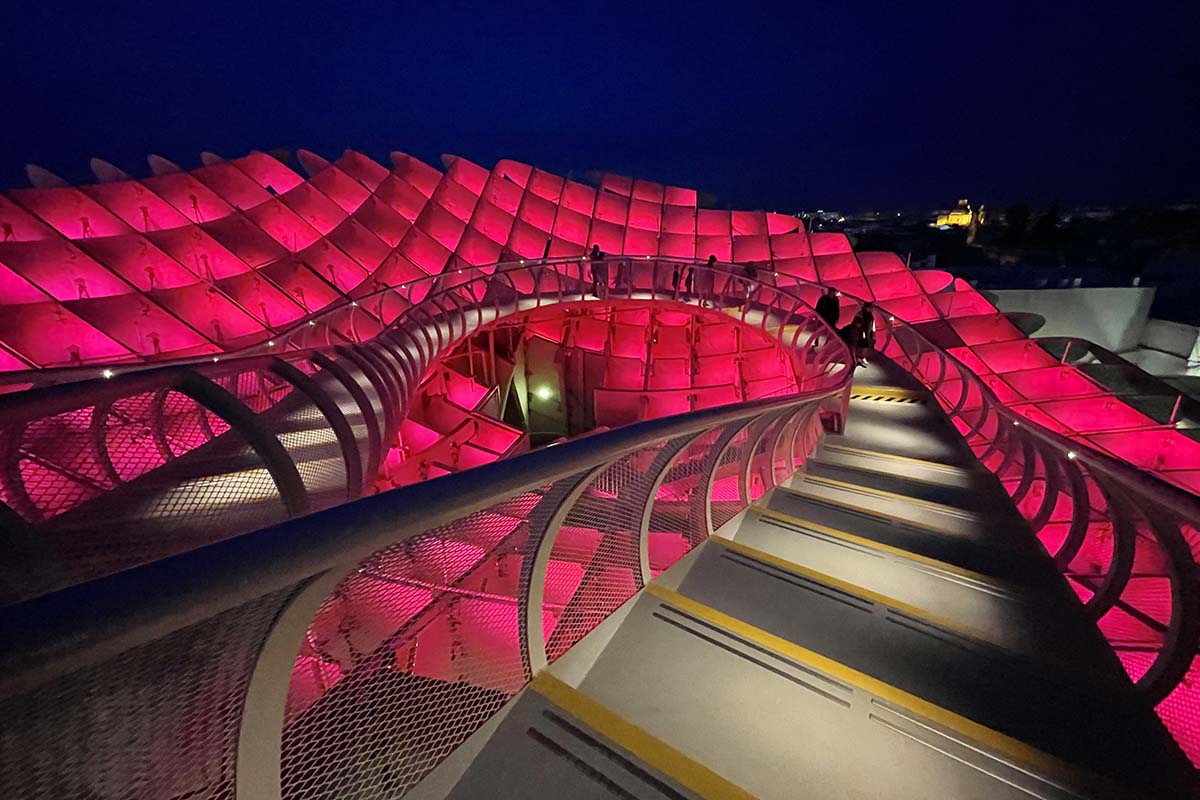
Calle Sierpes & Dinner
EVENING
End your day with a walk through Calle Sierpes, one of the nicest little shopping streets in Seville.
You may want to know that most shops in the center close for siesta in the afternoon and start to reopen at around 5-5.30 PM. Tourist-oriented souvenir shops tend to stay open all day. In any case, most shops are open until 8-10 PM, so if you want to do some shopping or get souvenirs, you can do it in the evening.
For dinner, there are so many amazing restaurants and tapas bars that you won’t have trouble finding something nice. However, if you absolutely want to dine at a specific place, be sure to reserve a table in advance.
TIP: Check out the restaurant La Malvaloca at the southern end of the square overlooking Setas de Seville. We had dinner here and their tapas were among the best we had anywhere in Spain, plus, we had a great view of Setas de Seville which was beautifully lit up in the dark. Alternatively, the restaurant Doña Encarna just nearby is another great choice too. We indicated both of them on our map.

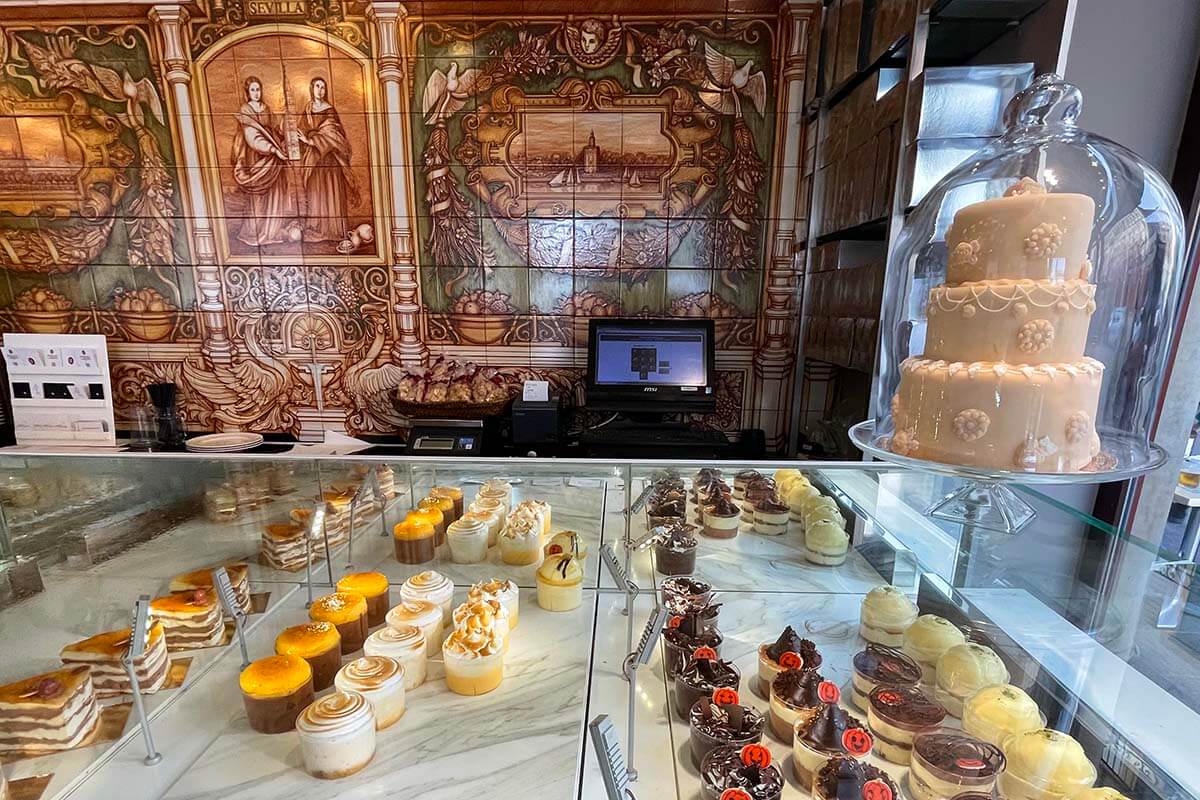
DAY 2: Royal Alcazar, Triana, Bull Arena, Riverside & Flamenco
This is what your second day in Seville could look like:
Royal Alcázar of Seville
(8.30) 9.30 – 11 AM.
The Royal Alcazar of Seville (Real Alcázar de Sevilla) is another must-see in the city. It’s located in the old town, just steps away from the Cathedral. As already mentioned, you could easily visit these landmarks on the same day, with two days in Seville, we recommend doing one each day. That way, it will be less rushed and you’ll likely enjoy it more.
The Alcazar is a big and very impressive palace complex with multiple buildings and lovely gardens. It was built by different rulers over a period spanning several centuries, so the result is a mix of various architectural styles.
There is a very strong Moorish influence, but also Baroque and Renaissance elements; it’s truly unique.
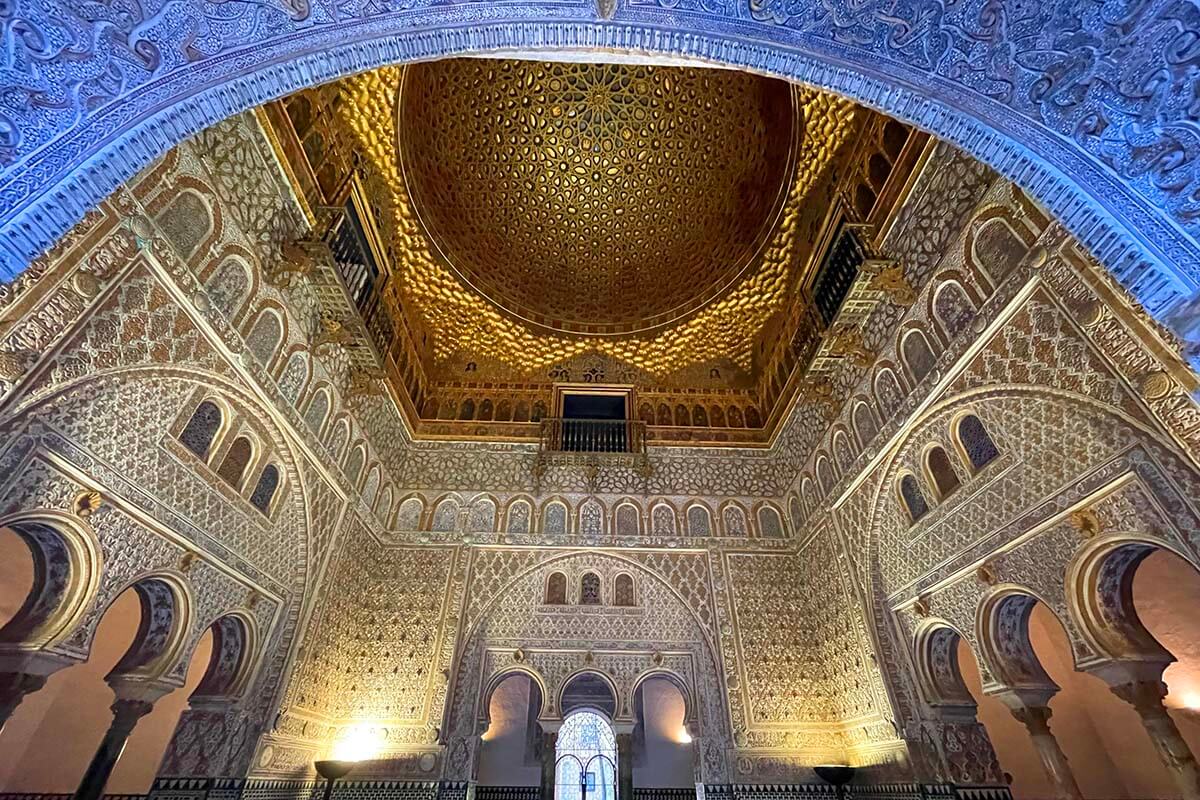
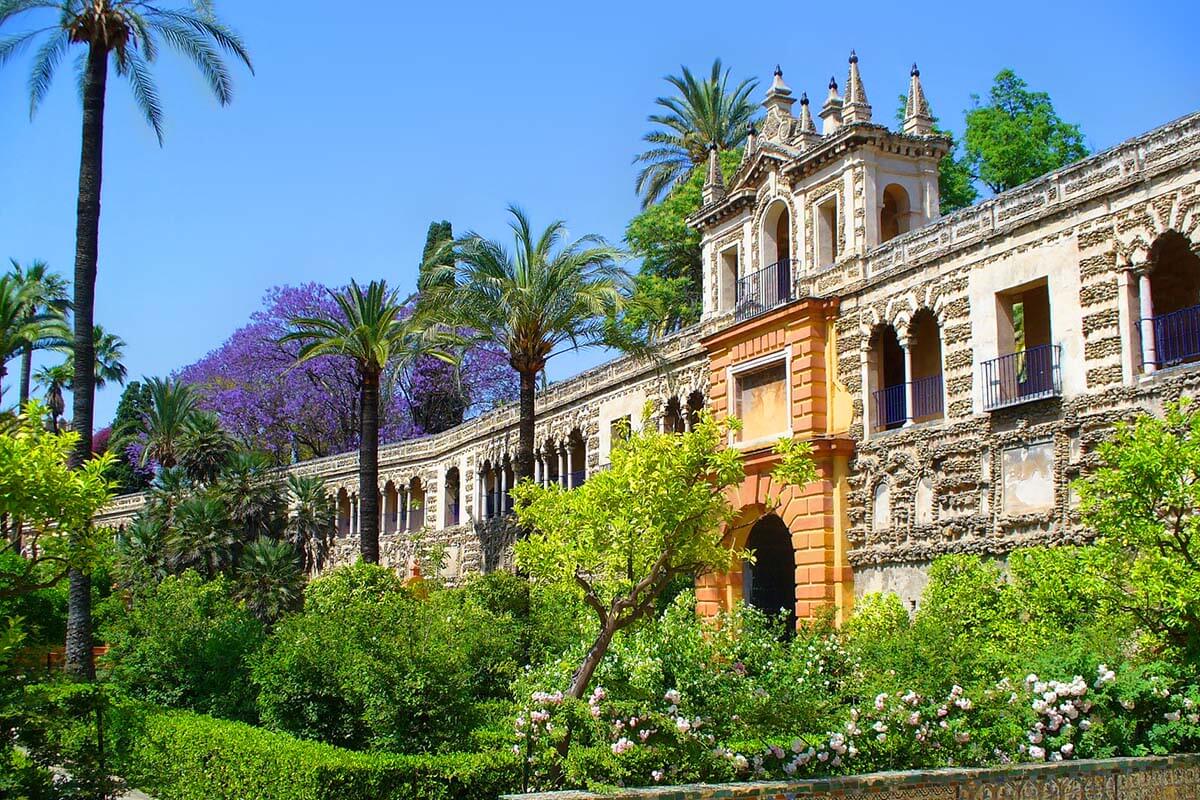
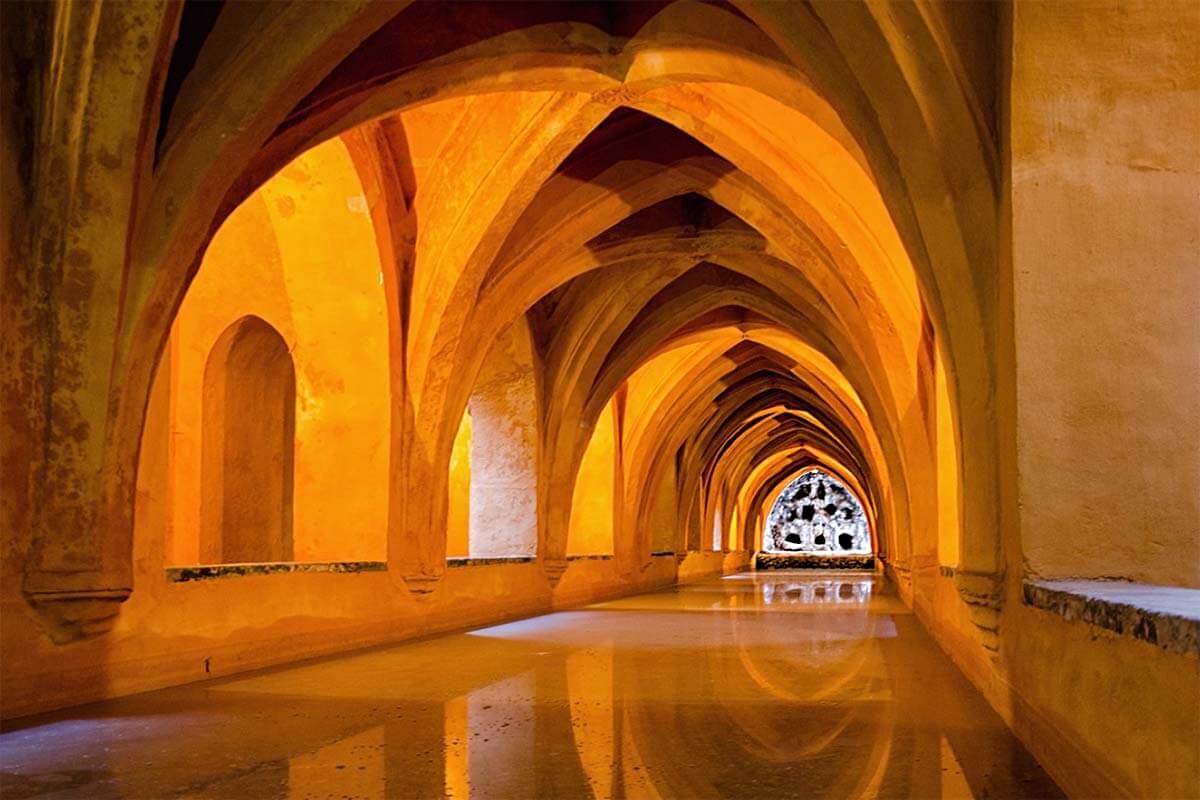
You could easily spend half a day exploring the palace and the gardens, so ideally, you plan at least 1.5 – 2 hours inside and also leave some extra time in between this and other activities so that you can stay a bit longer if you feel like it.
TIP: Make sure to book your tickets in advance and try to get the earliest possible time slot (or the earliest tour). The palace typically opens at 9.30 AM and by 9 AM there is already a queue that stretches for a few blocks…
Planning info: For this itinerary, we recommend either timed-entry tickets (book the 9.30 AM slot and arrive earlier!) or this amazing ‘Alone in the Alcazar’ tour which starts at 8.30 AM (yes, an hour before it opens to the public!). We took this tour and it was amazing. However, these tours only run a few times a week and availability is very limited. So check if it’s available for your travel dates and if it is, don’t hesitate – it’s a very unique experience.
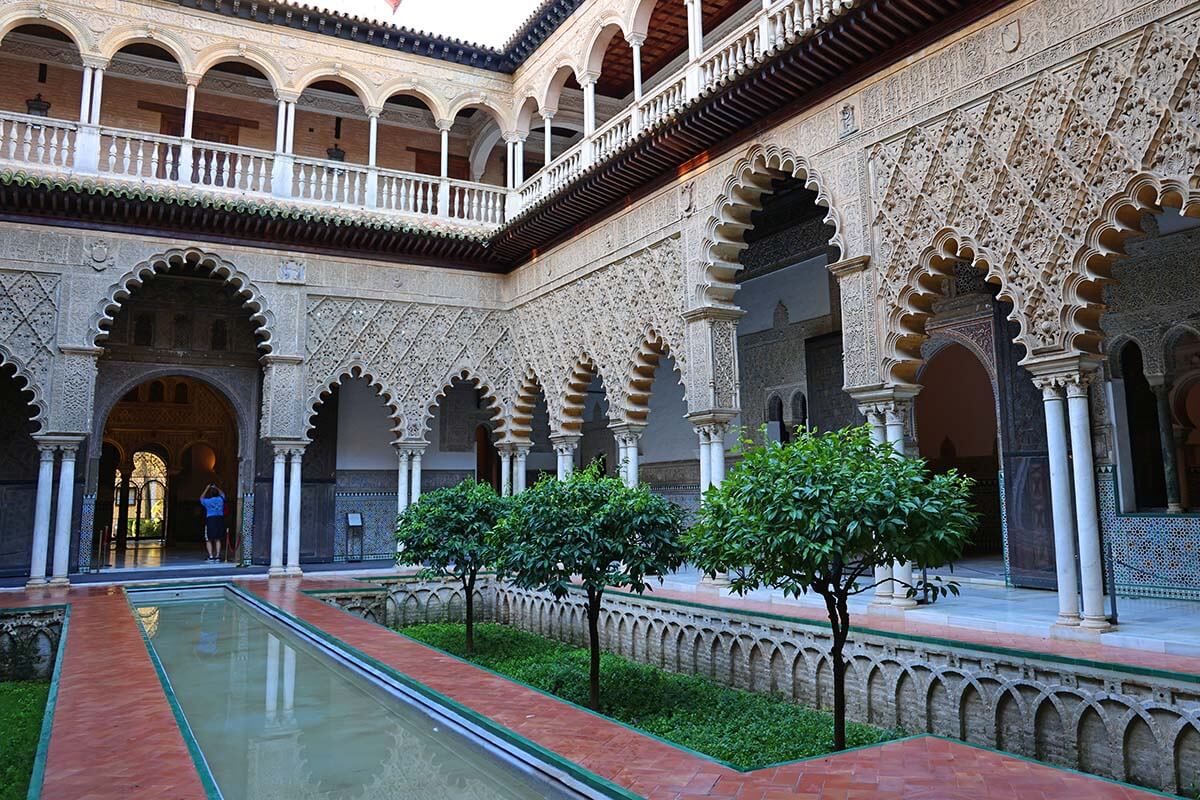
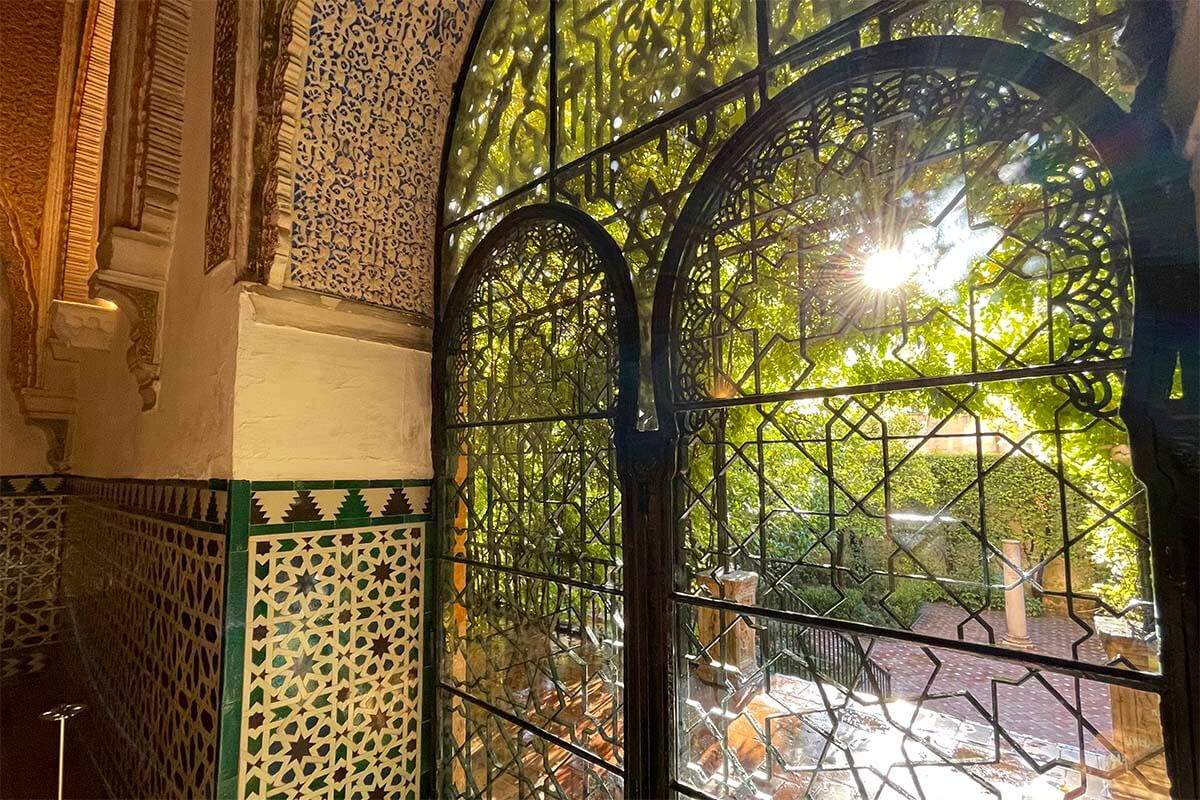
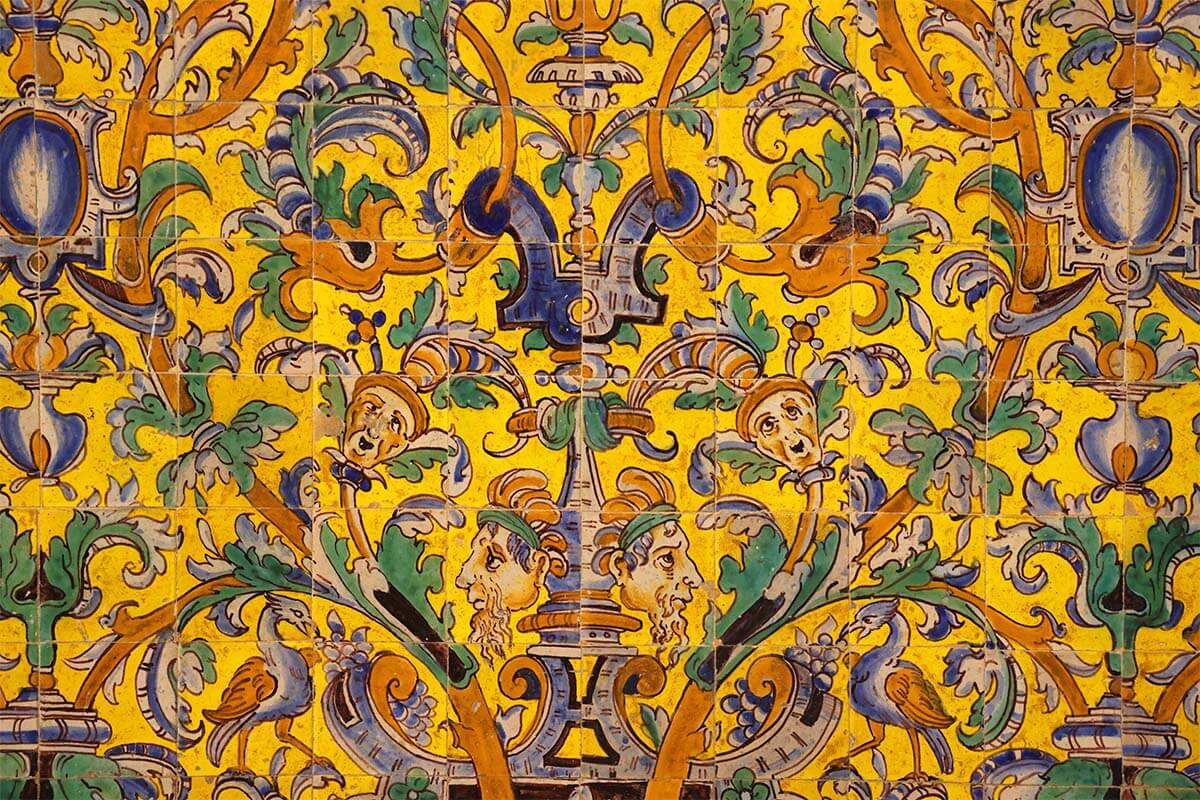
General Archive of the Indies and/or Plaza del Cabildo
11 – 11.30 AM (OPTIONAL).
If you leave Alcazar well before noon, you could visit a few other places nearby. These are not a must, but they are close by, don’t require any additional planning, and are free to visit, so you can also just decide on the day itself.
General Archive of the Indies (Archivo de Indias) is an archive/library that holds the original documents about Spain’s colonization of the New World. The archive is located inside a beautiful 16th-century merchants’ exchange building located on the square between the Royal Alcazar and the Cathedral.
Plaza del Cabildo is somewhat of a hidden gem located a few minutes walk from the main attractions (and on the way to the next stop on this itinerary). It’s a picturesque little square encircled by a half-moon-shaped arched building. Sometimes, there is a flea market here, but it’s worth passing by either way.
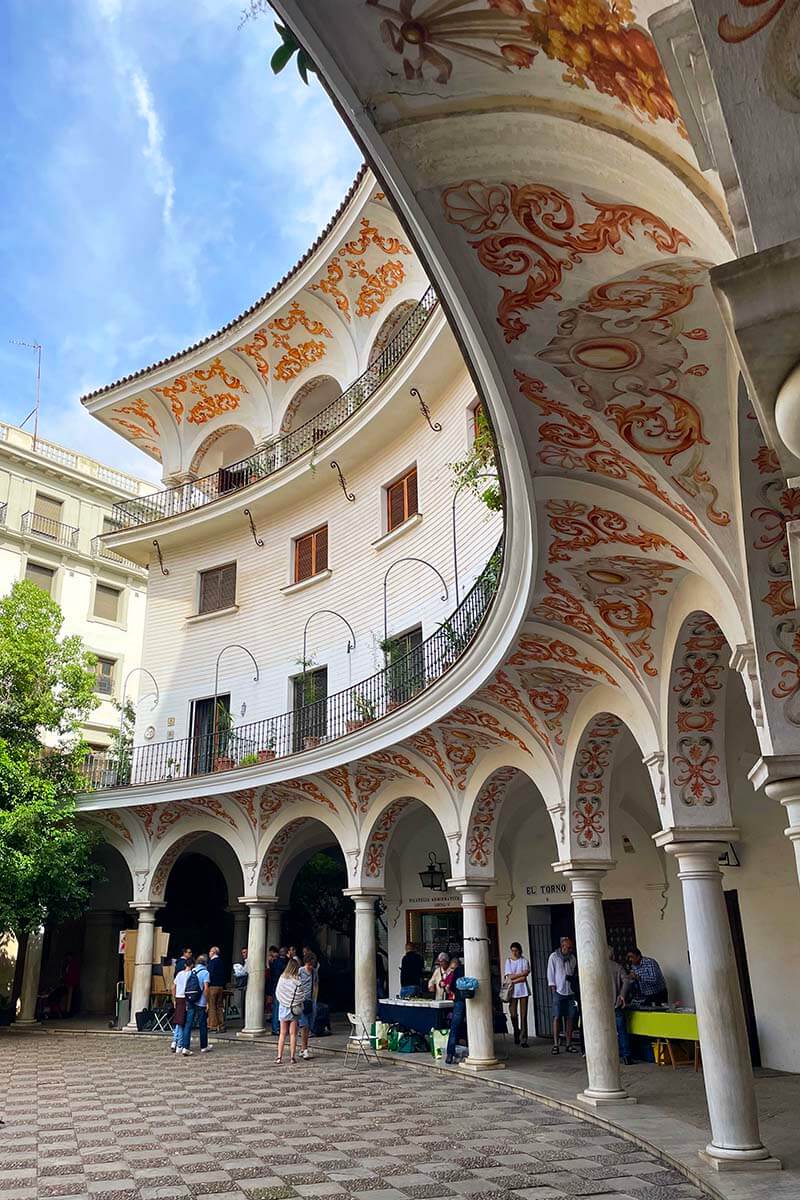
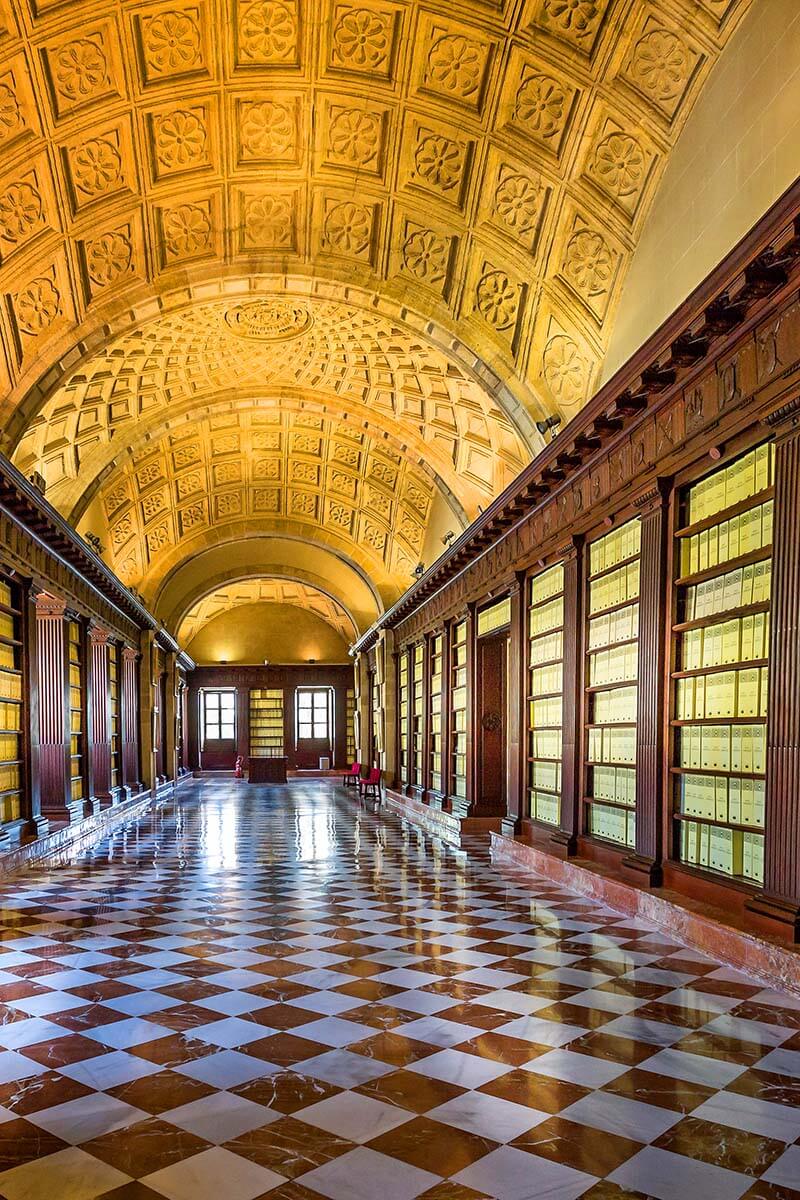
Triana Market & Lunch
12 – 2 PM.
If you want to see a somewhat more local side of Seville, head to the Triana neighborhood on the other side of the Guadalquivir River. Triana is known as the birthplace of flamenco and is also the area where many famous bullfighters and sailors came from.
Here, you can visit Triana Market (Mercado de Triana), which is an excellent place for lunch. This is a covered food market that has a mix of traditional market stalls, some of which also have several tables where you can sit down for a traditional meal. In addition, you’ll also find many good restaurants in the neighborhood. We indicated quite a few excellent choices on our map.
While this is the most famous market in Seville, it kept its original charm and is not nearly as touristy as the main markets in e.g. Barcelona or Madrid. If you want to try all kinds of local hams, this is a great place for that, but there are also plenty of other choices – from tapas to paella and everything in between.
Good to know: The market is open daily except on Sunday when most market stalls are closed. And while there is still plenty of choice of places to eat, for the best atmosphere it’s best to visit between Monday and Saturday.
TIP: If you are interested, there is a highly-rated food tour that you could easily fit into this itinerary (+-11.30 – 2 PM). We personally absolutely love taking food tours with locals when we travel! In Seville, we did another food tour, for dinner, in combination with a Flamenco show; you can find more info about it further below.
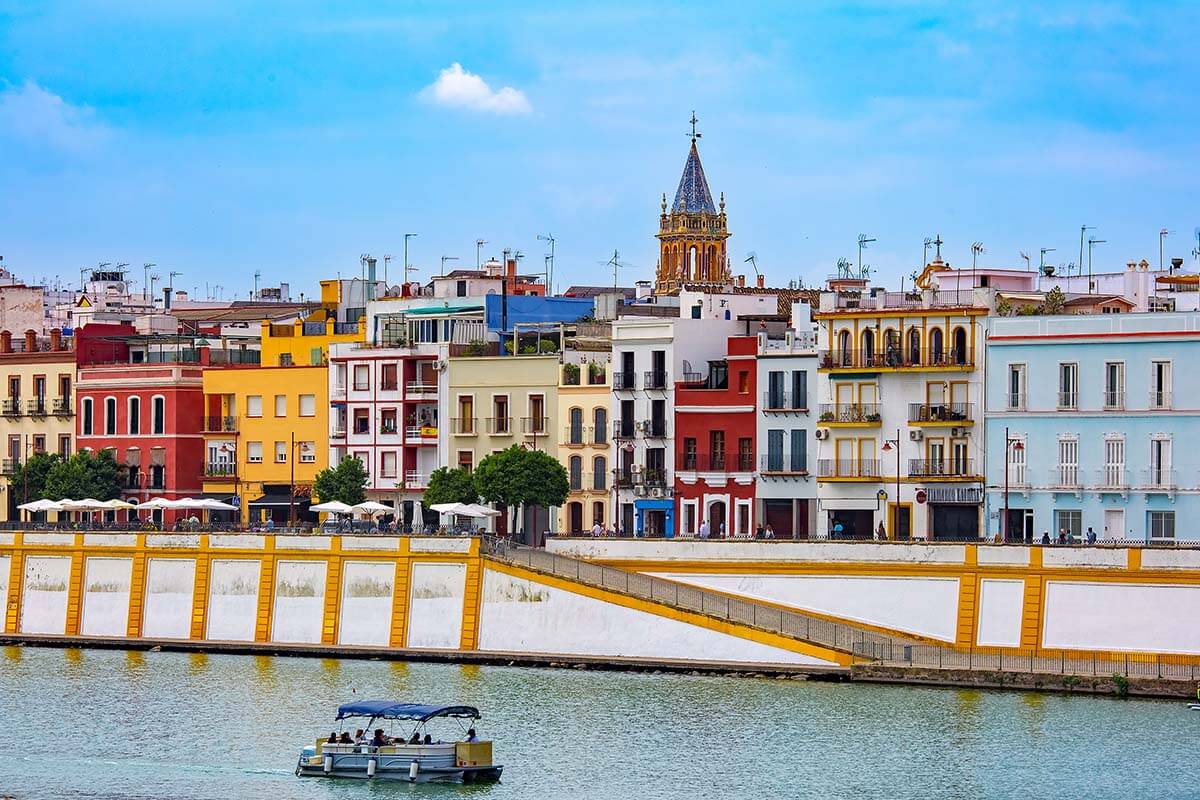
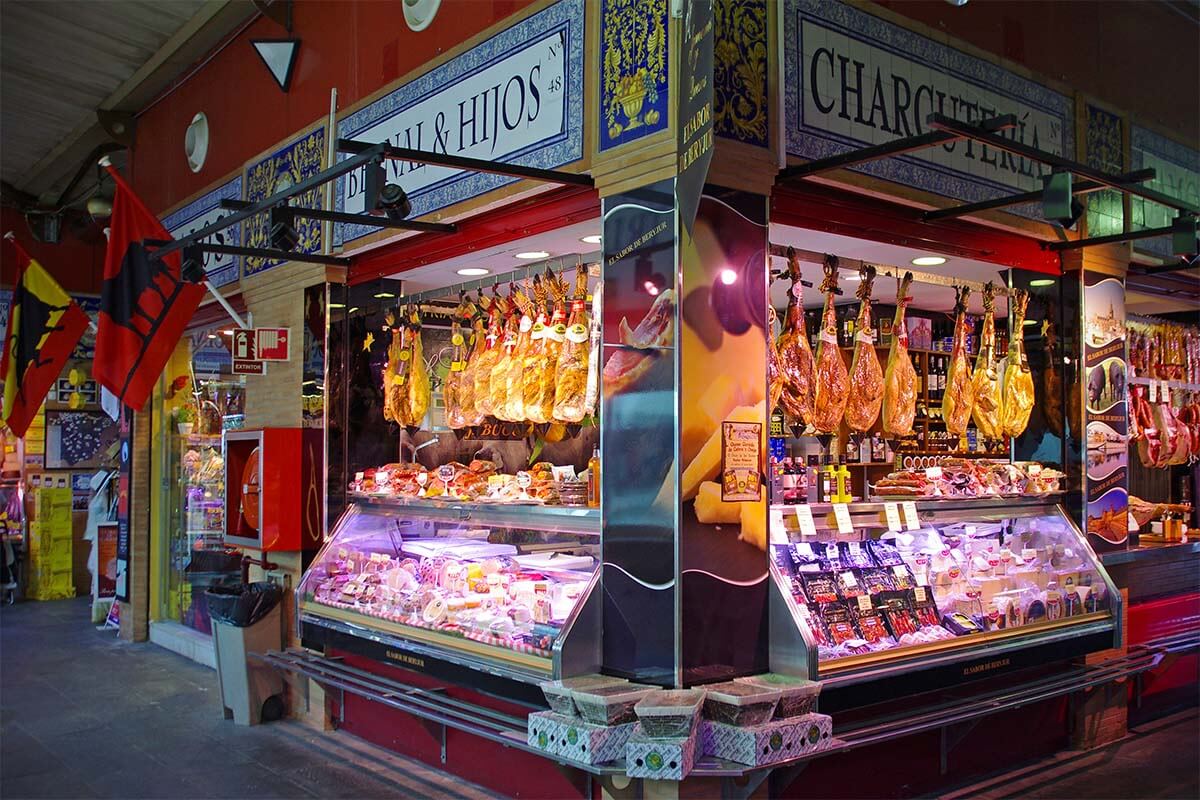
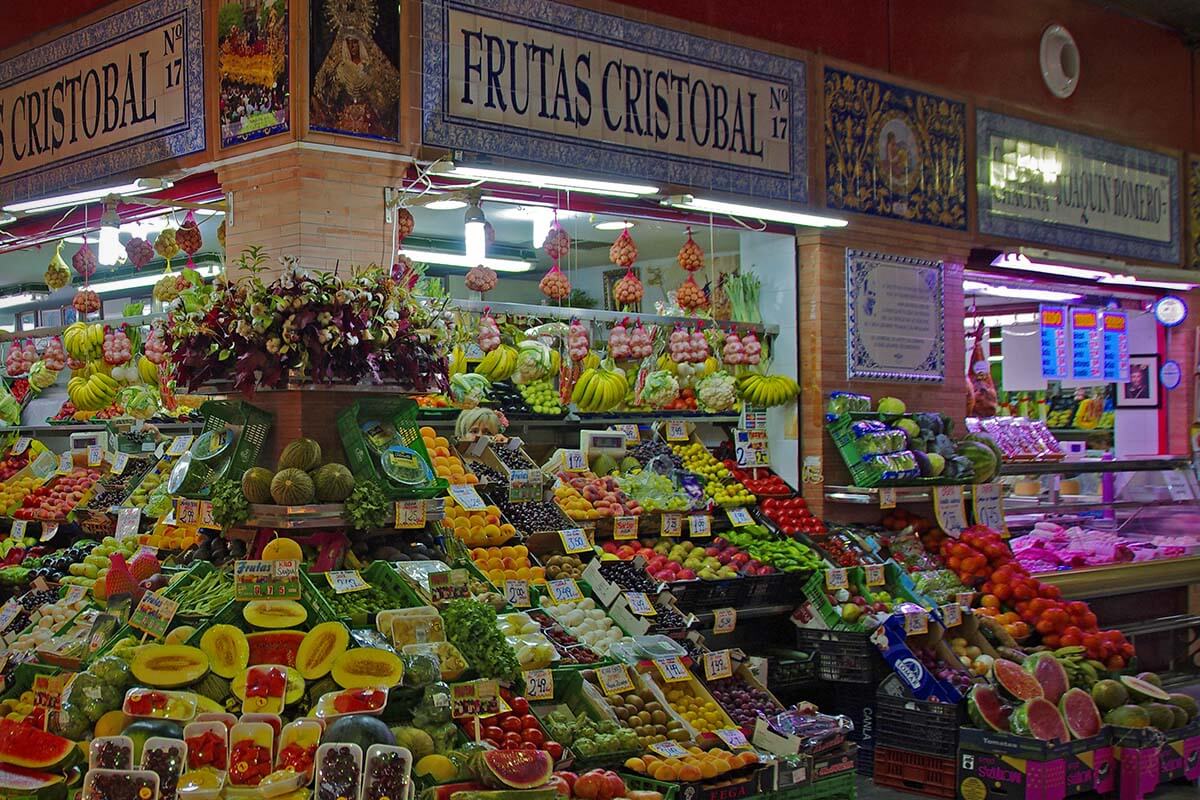
Bullring – La Real Maestranza
2.15 – 3 PM.
Next, you could visit the bullring of Seville (Plaza de Toros de la Real Maestranza de Caballería de Sevilla). It’s located in the old town and you’ll actually pass it on your way to Triana. So depending on your preferences, you could either stop here on your way to the market or after lunch.
The bullring of Seville is one of the oldest in Spain, dating from the 18 – 19th centuries. It’s still used for bullfighting nowadays and is considered one of the most prestigious arenas in the world.
The bullfighting season in Seville is rather short, with over a dozen flights per year. Most events take place in April and early summer. For the rest of the time, the arena functions as a museum.
While we don’t support bullfighting and I wouldn’t think of going to see a corrida, we found a visit to the arena very interesting and intriguing. It’s such an old tradition that no trip to Spain would be complete without learning more about it. And visiting a museum like this is a great way to do this. You can see bullfighters’ costumes, take a look behind the scenes, see Capilla de los Toreros (Bullfighters’ Chapel) and of course, explore the arena itself.
While there are guided tours available, you can easily visit the arena on your own. For more information, you can also download a free audioguide once you are inside the museum.
Planning info: You need about half an hour for a visit. However, sometimes, there is a long queue at the ticket desk. If you want to be able to enter without a wait, you can book your tickets online in advance.
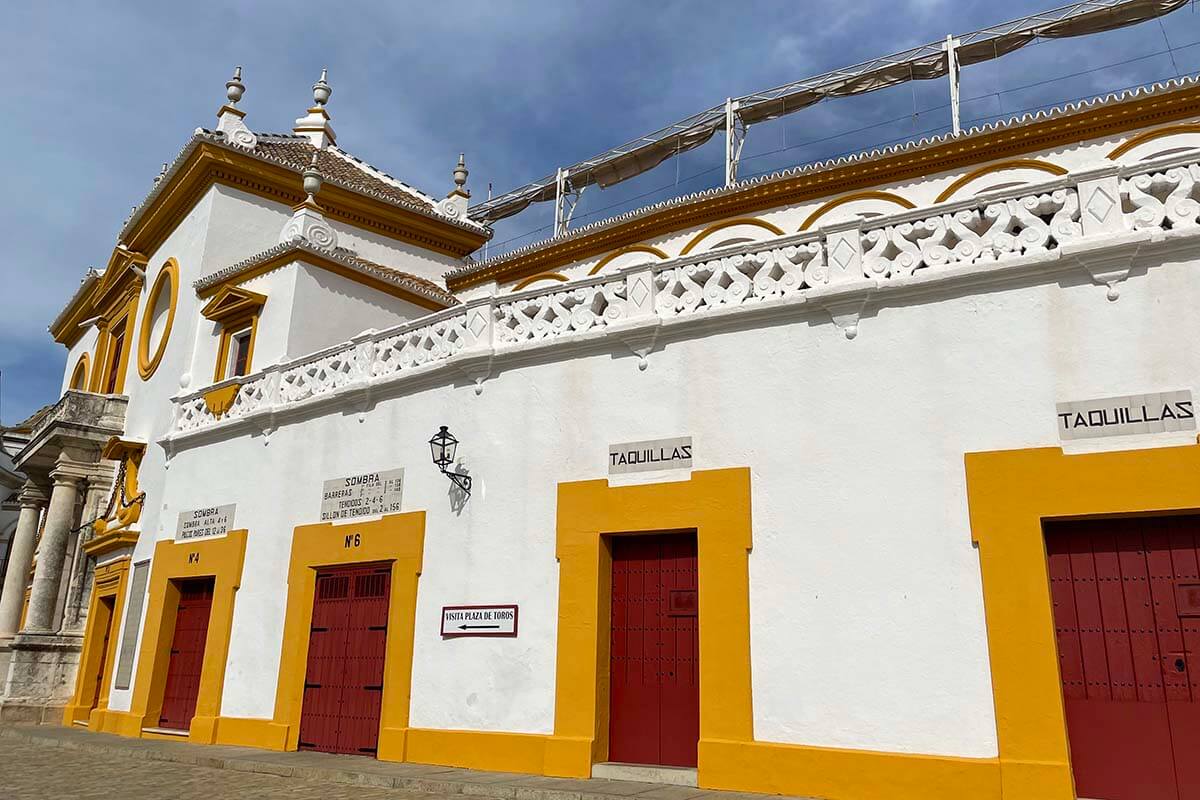
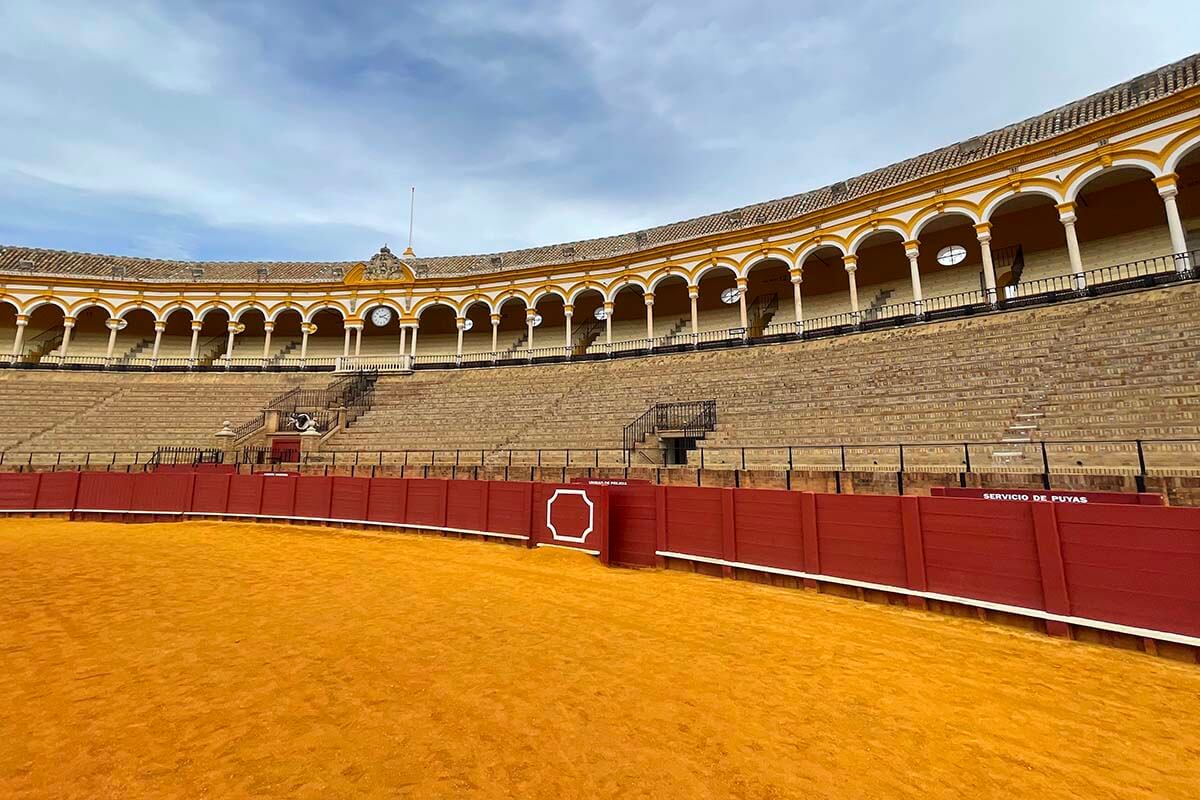
Golden Tower, Nao Victoria 500 & River Cruise
3 – 4.30 PM.
Next, take a walk on the pedestrian promenade next to the Guadalquivir River. There are two main landmarks here: Nao Victoria 500 and Golden Tower (Torre del Oro). In addition, you can also take a Guadalquivir River Sightseeing Cruise.
Nao Victoria 500 is a replica of the first ship that circumnavigated the world. There is a small museum inside and it’s quite interesting, but the entrance fee is quite steep and some people find that it’s not worth it. So I’ll leave it up to you to decide. If you are visiting Seville with kids, then you may want to check it out.
Torre del Oro (the Golden Tower) is a 13th-century military watchtower that later served as a prison. Nowadays, the tower houses a maritime museum, but most people visit it for the views from the top.
While the views are nice, we found them not as impressive as the views you have from Giralda Tower, Cathedral Rooftops, or even Setas de Sevilla. So I would only visit if there is no wait or if you are absolutely interested in the museum. Otherwise, just admire the tower from the outside – it’s way more impressive.
TIP: If you want to see Seville from a different perspective, you could also take a sightseeing river cruise. Most cruises take 1 hour and there are various options throughout the day, varying from big boat to private boat tours. It’s a nice way to see more of the city without having to walk in the heat. We recommend this company, which also offers quite an affordable private-tour option. In any case, I would book in advance – that way, you can just arrive a few minutes in advance and are sure to have a spot without an extra wait.
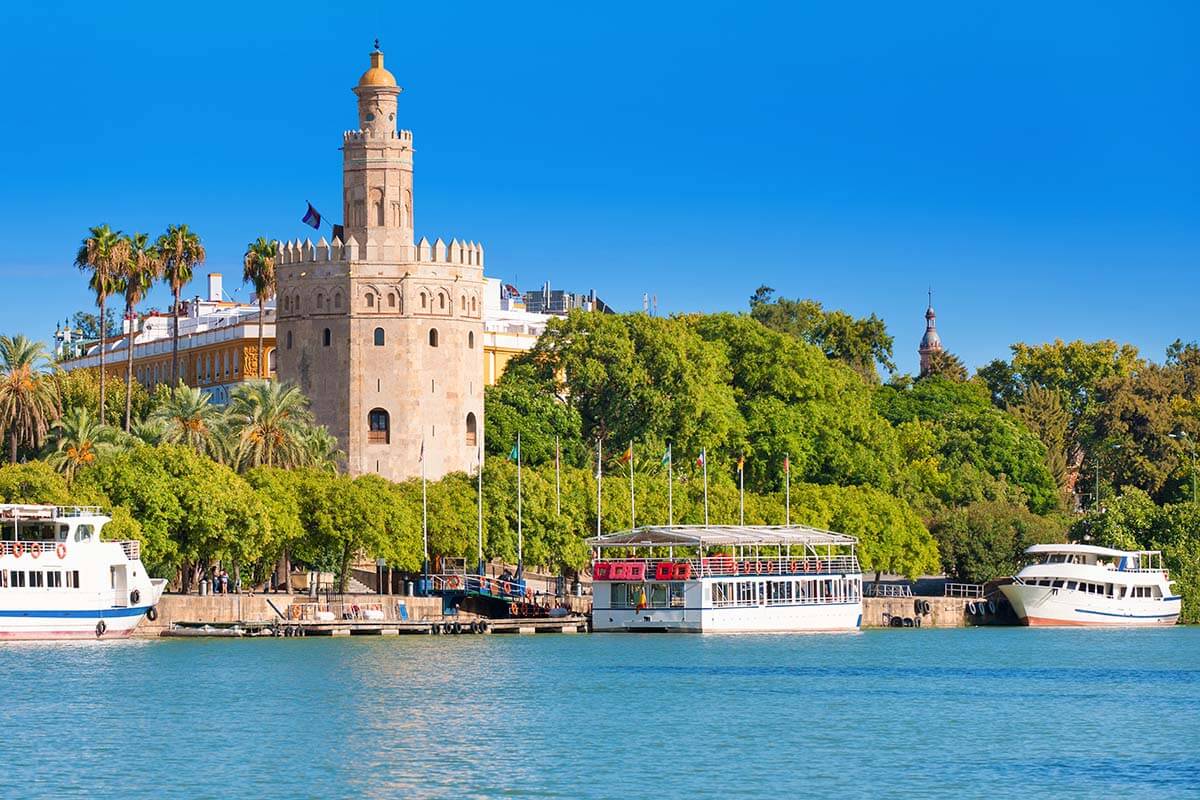
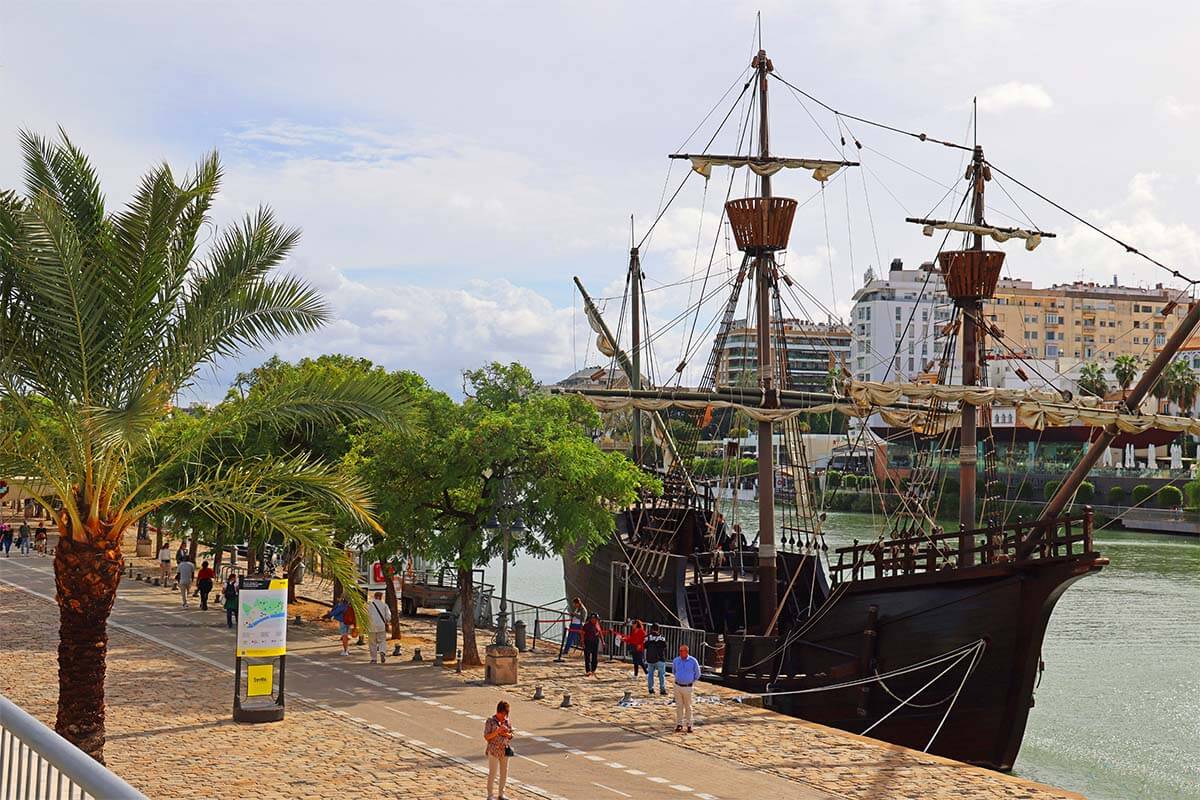
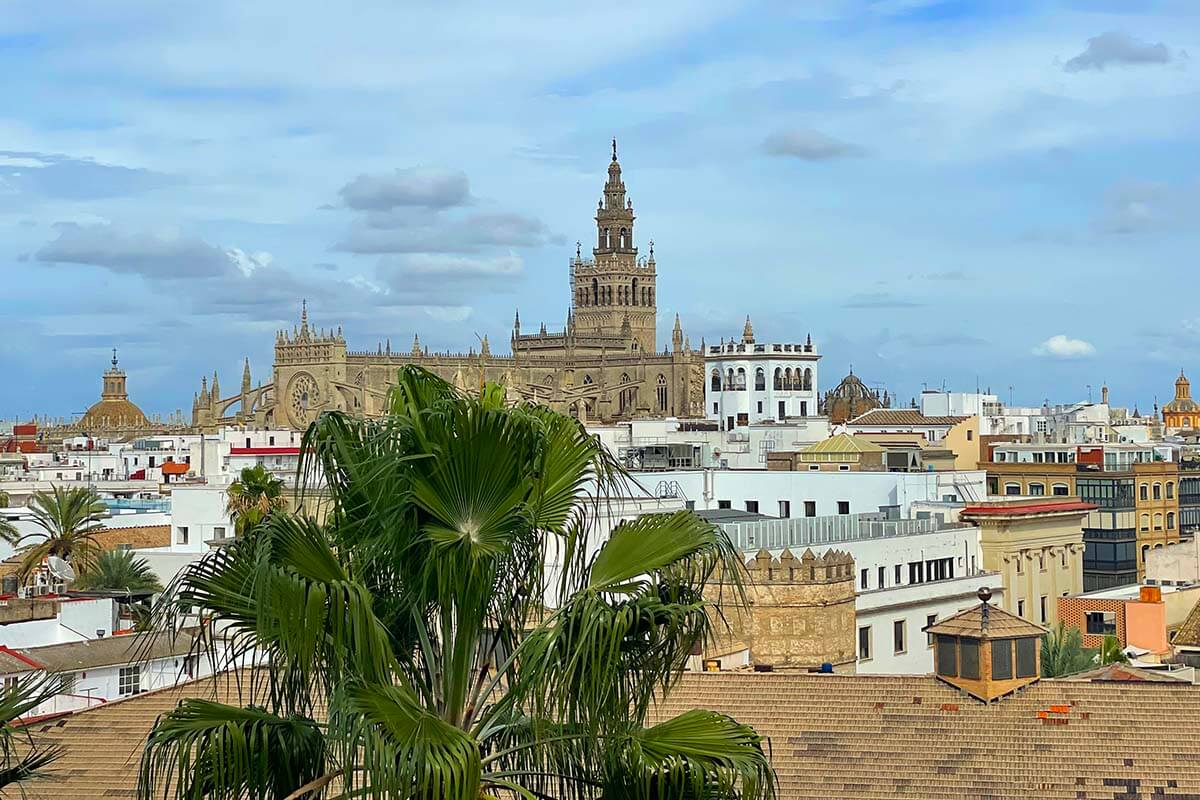
Flamenco & Tapas Dinner Tour
TIMING DEPENDS ON WHICH OPTION YOU CHOOSE.
Seville is the birthplace of Flamenco dance, so no visit would be complete without seeing a Flamenco show. There are tons of places where you can see Flamenco dancers in Seville, however, for the most authentic experience, you should go to a small traditional theater.
These little theaters have a very intimate setting with the public sitting very close to the performers, and they work with professional artists and musicians. The best shows are usually completely improvised on the spot. It’s a wonderful experience!
Here are a few options that you could choose from, depending on your interests:
OPTION 1: Flamenco + tapas tour (this is what we did). This small-group tour includes a traditional Flamenco show and a great selection of tapas and drinks at several locations before and after the show. This tour takes 4 hours, but there’s more sitting and eating than walking. It’s a very relaxing experience, like going out for an evening with a local friend. We did it with our teens and they loved it too. To my husband, this was the best experience in Seville.
Good to know: This tour normally starts at Plaza de San Francisco, about 15 minutes walk from the river. On the way there, you could also check out the beautiful buildings of Palacio de San Telmo. The San Francisco Square itself is very beautiful too – well worth seeing either way!
LEARN MORE: Seville Flamenco & Tapas Tour Review
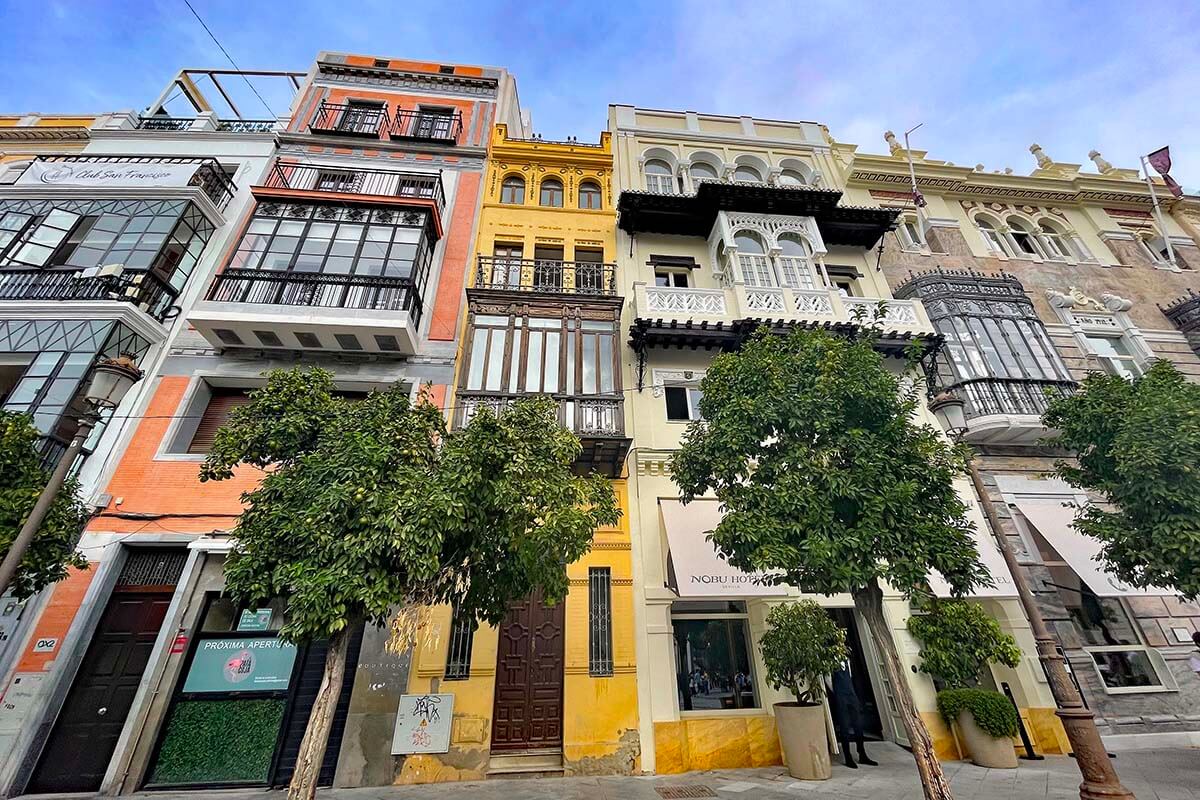
OPTION 2: Flamenco in the old town, for example at Flamenco Museum (you can choose to just see the show or to also visit the museum) or at Casa de la Memoria. After the show, you can find a nice restaurant for dinner nearby.
OPTION 3: Flamenco at Teatro Flamenco Triana. This is the neighborhood where this dance is said to have originated (and that we recommended in this itinerary for lunch). However, if you decide to see a Flamenco here, change this itinerary a bit, have lunch in the old town, and visit this part of town in the evening. The market will be closed, but there are plenty of nice restaurants for dinner.
You will find all these theaters indicated on our map (at the top of the article). We also indicated lots of nice restaurants in each area.
YOU MAY ALSO LIKE TO READ: Best Things to Do in Spain (Top Sights & Experiences)

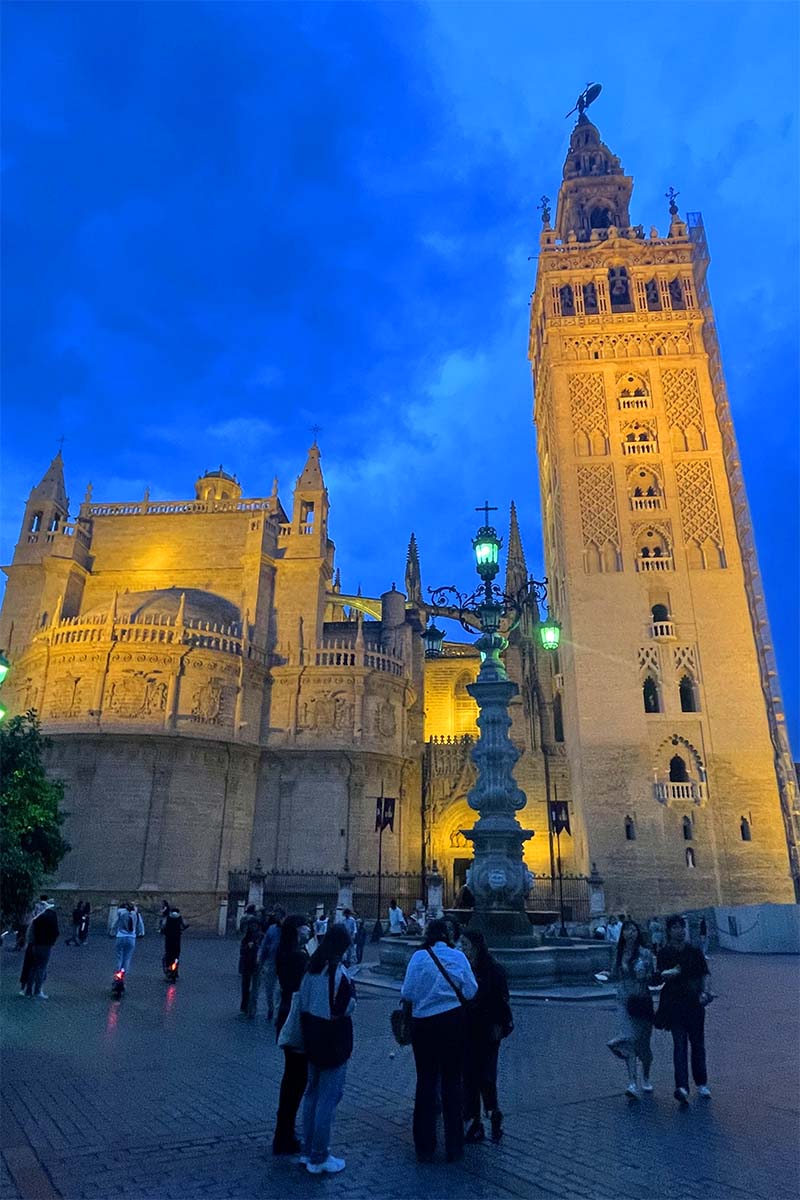
Where to Stay for Sightseeing in Seville
With just a few days in Seville, we recommend staying in the old town. Not only will you be able to easily walk everywhere, but it will also allow you to maximize your sightseeing time. Plus, if you are traveling in the warmest months, you can go back to your hotel for an afternoon siesta.
TIP: In the summer season (+- May – October), look for a hotel with a swimming pool. And – especially if renting private apartments – be sure to double-check if they have air conditioning!
Here are some of the best-rated hotels in the old town for all budgets:
- €€€€€€€€€+ Hotel Alfonso XIII – the iconic historic grand hotel.
- €€€€€ Radisson Magdalena Plaza – a very highly-rated modern 5* hotel.
- €€€€ Hotel Amadeus Sevilla – a charming, music-themed boutique 4* hotel.
- €€€ Hotel Doña María – a very popular mid-budget 4* hotel in an old palace.
- €€ Hotel Cervantes – a good value hotel a bit outside of the main tourist areas (this one has no pool).
READ ALSO: Traveling to Barcelona: Tips for Your First Visit
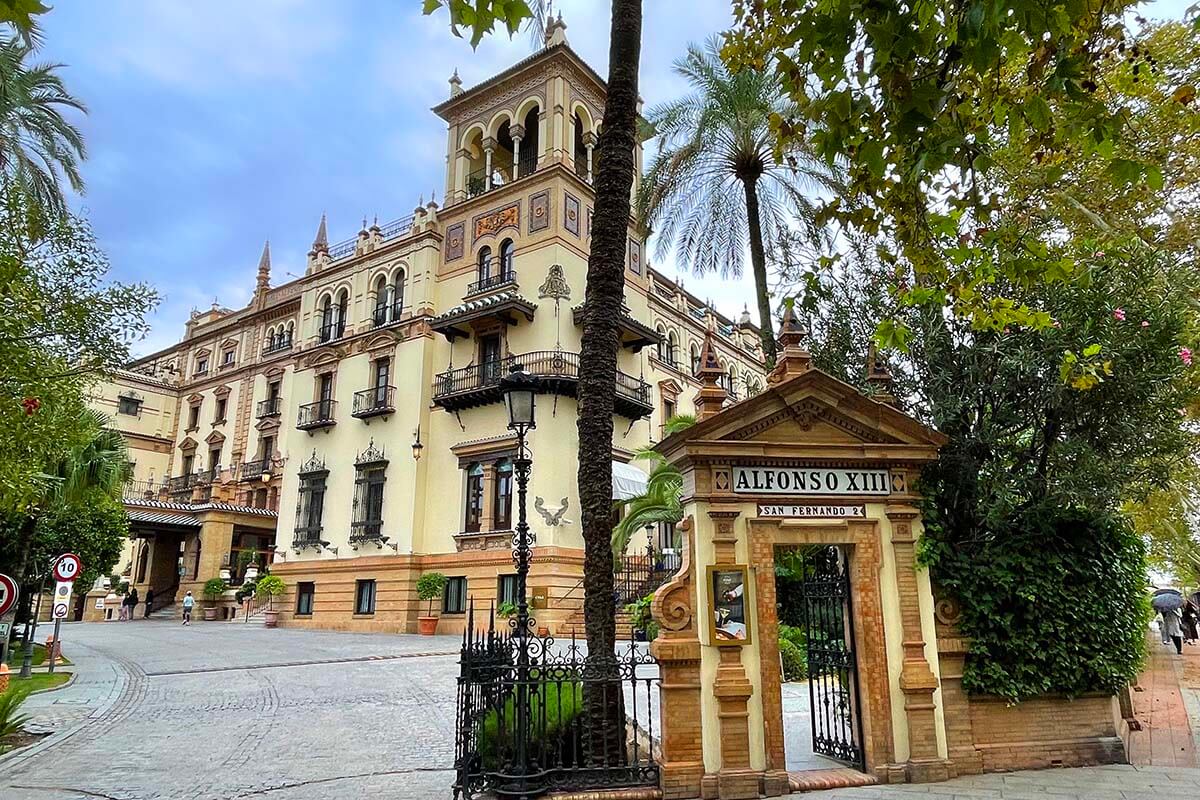
So, this is our suggested itinerary for a first 2-day visit to Seville. I hope that it gives you a better idea of what you can expect and helps you plan a memorable trip.
Have a great time in Andalusia!
More travel inspiration for Spain:
- Best Things to Do in Barcelona
- Best Gaudi Tour in Barcelona
- 1 Day in Barcelona
- 2 Days in Barcelona
- 1 Day in Seville
- 1 Day in Madrid
- 2-3 Days in Barcelona
- How to Visit Montserrat from Barcelona
- Montserrat Tour Review
- Toledo Day Trip from Madrid
- San Sebastian – Bilbao Itinerary
- Best Things to Do in Bilbao
- 1 Day in Bilbao
- How to Visit Gaztelugatxe
TIP: If you are also visiting Portugal on this trip, check out our Portugal travel page. We travel to Portugal all the time and have tons of articles covering many popular destinations all over the country.
TIP: Did you find this guide helpful? Bookmark this post for later, share it with your friends, and save it to Pinterest to inspire your next trip.
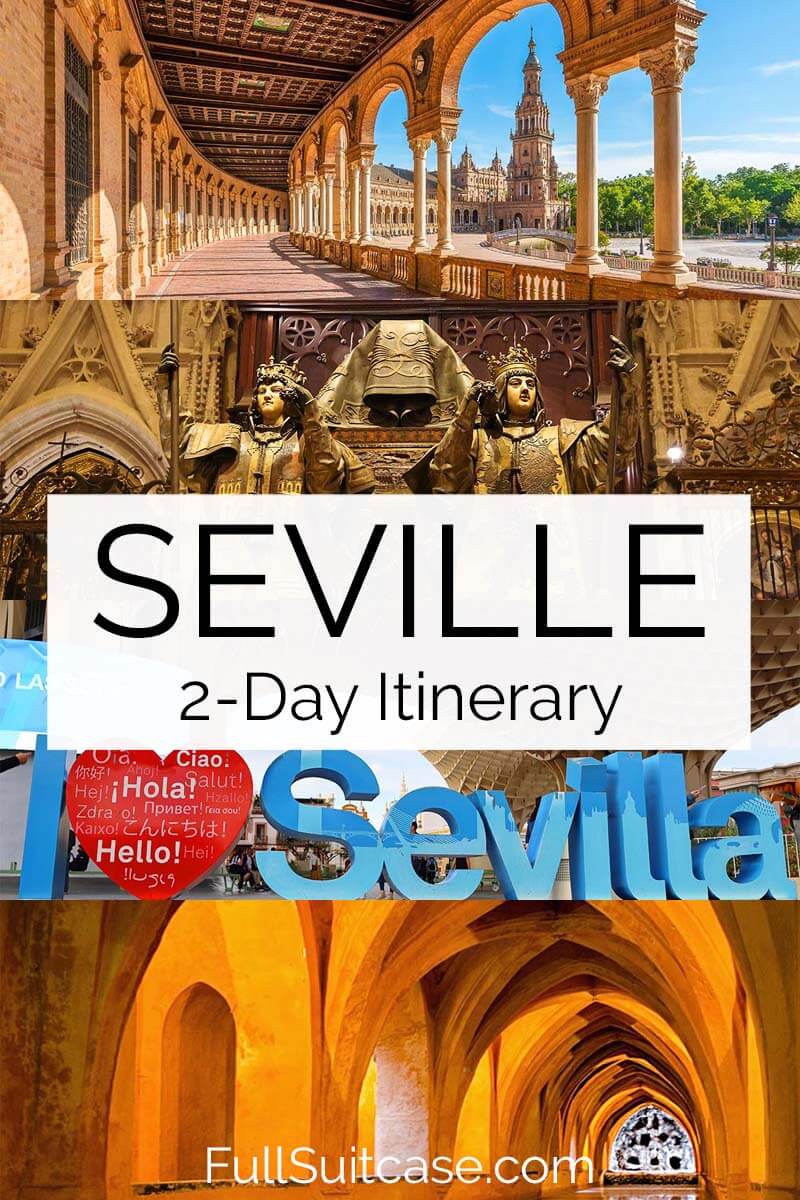
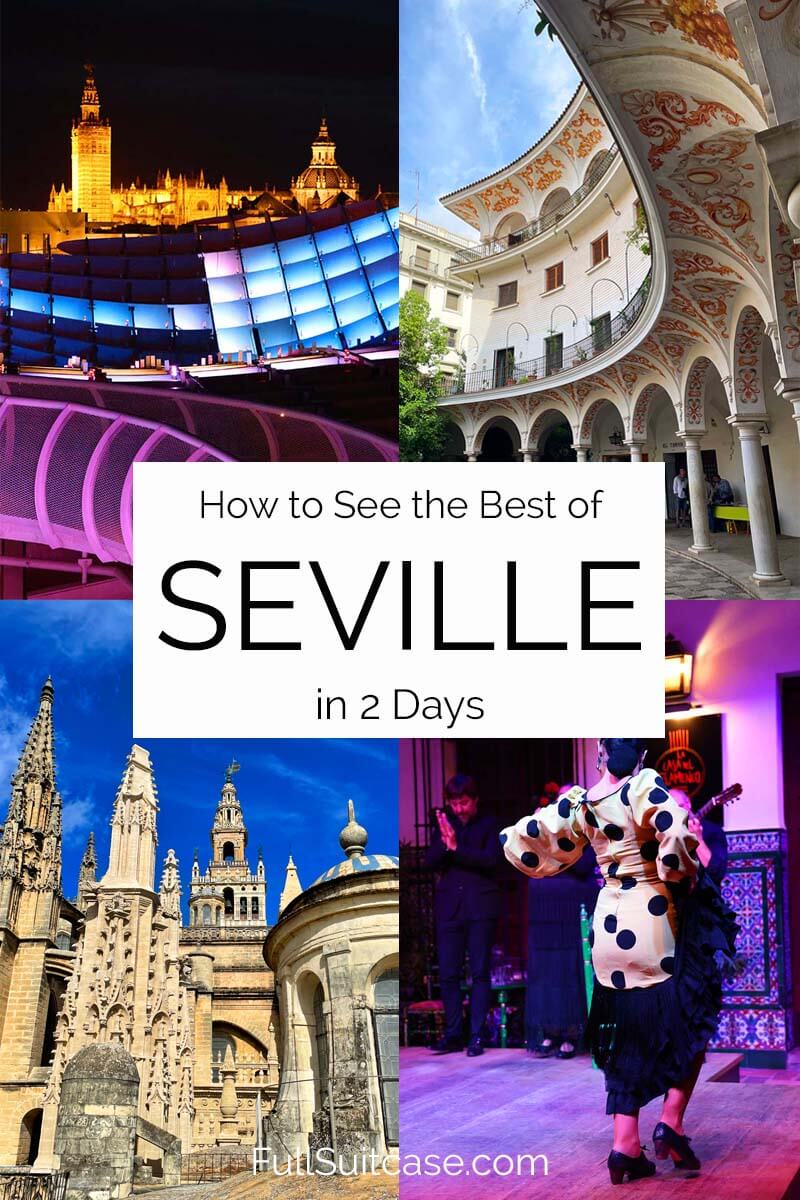




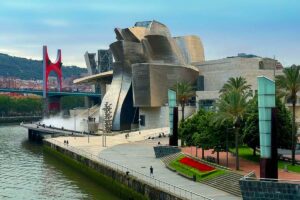
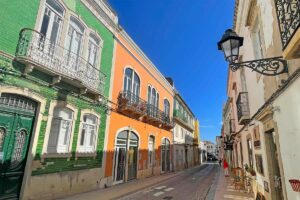

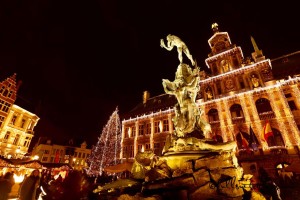
Hi Jurga,
Absolutely love your maps and guides! Do you have one for the South of France… from Italy or the South East of France to Barcelona seems to be an trip many people don’t post about (e.g. Venice or start Nice then South West to Andorra and Barcelona).
Do you have any guides or tips to do this route?
Hi Sek, no, we don’t have many articles about France and nothing from that part of the country. It’s just been too long since we’ve visited, long before I started this blog.
You can find our Barcelona articles here and Italy here.